
 August 29, 2025 "Feeding the Masses?"
August 29, 2025 "Feeding the Masses?"
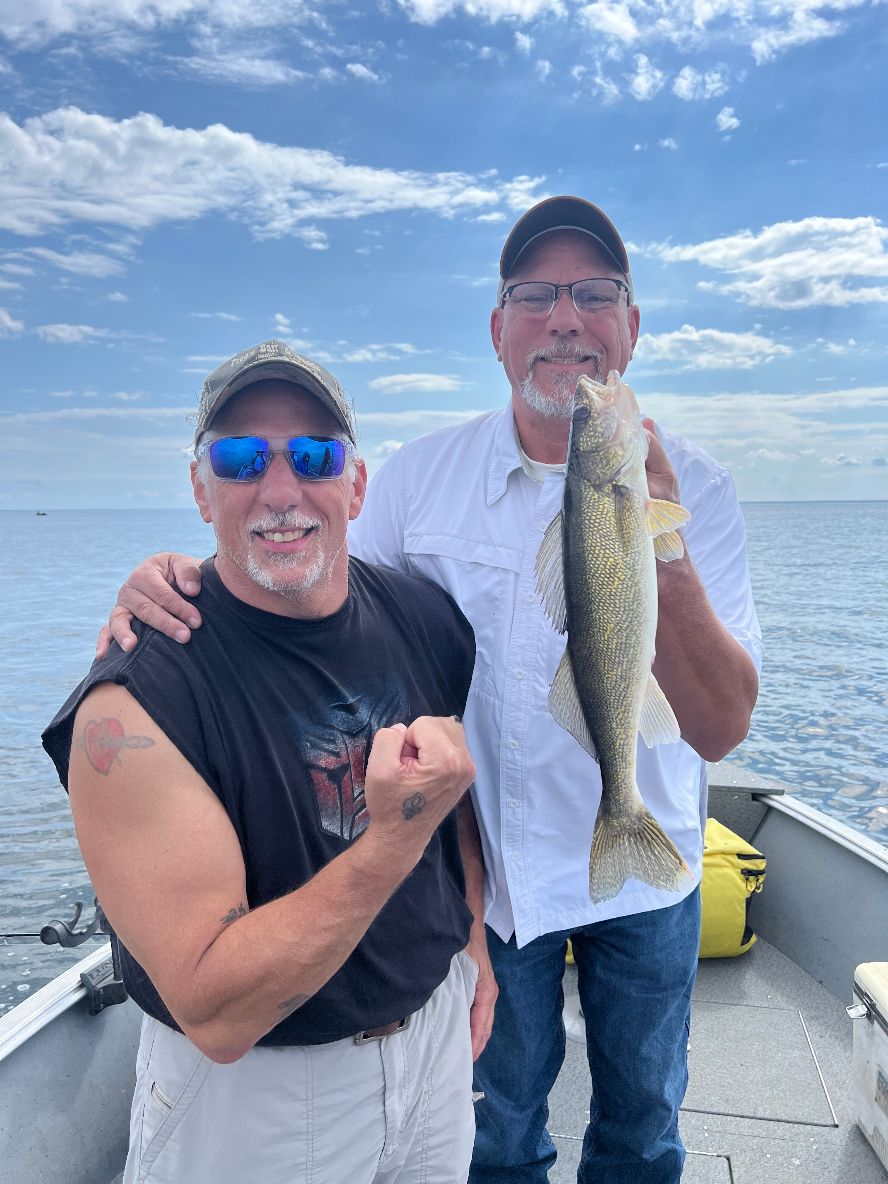 “The action is just good enough to keep us interested in staying here.” So said one of the fishing guides we passed by on Lake Winnie this Wednesday. What he meant by saying that was that he and his crew, along with me and my crew, were catching walleyes, but at a slow pace. I’d guess we were catching walleyes at a pace of about 1 fish every half hour.
“The action is just good enough to keep us interested in staying here.” So said one of the fishing guides we passed by on Lake Winnie this Wednesday. What he meant by saying that was that he and his crew, along with me and my crew, were catching walleyes, but at a slow pace. I’d guess we were catching walleyes at a pace of about 1 fish every half hour.
I know, that doesn’t sound too good, does it? But if you first consider the weather conditions, calm water with partly sunny skies, then compare Wednesday’s fishing activity to what’s been happening on Winnie under similar conditions lately, the slow-but-steady action seemed pretty good, at least it did to me. Nobody would describe the fishing action as great, maybe not even good, but the goal, amassing a larder sufficient to feed 4 adult men was achieved. Along with that, there were a couple of nice walleyes, and a half dozen jumbo perch left over to pack for the trip back home.
I’ll come back to Winnie, but first I’ll mention that on Thursday, fishing with another family for a hald day on Cass Lake, something similar happened. A walleye, followed by slow-but-steady action for “keeper” size perch felt familiar. While conditions were not ideal, they weren’t awful either. The skies were mostly sunny, but with a moderate southeast wind, there was a decent chop on the surface. The action was never so good to be called exciting, but it could have been better. On the other hand, it was never so bad that it was boring and by day’s end, we did gather enough perch to provide a family fish fry. Again, not a great fishing trip, but not all that bad either.
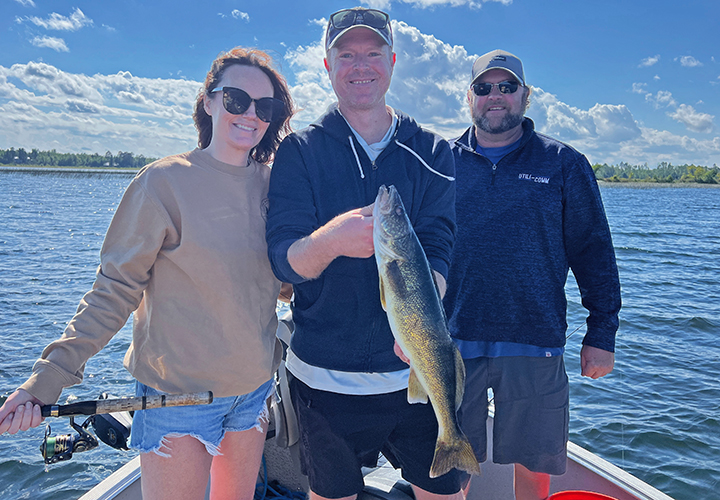 We often measure fish activity using weather and water conditions as the yardstick. So, throughout the week, I’ve been thinking a lot about that. Water temperatures are going down, and in terms of starting up the “fall bite”, that’s good. On Winnie, the surface temperature ranged from about 68 to 69 degrees on Wednesday. On Cass Lake, it was slightly warmer, in the 71-to-72-degree range.
We often measure fish activity using weather and water conditions as the yardstick. So, throughout the week, I’ve been thinking a lot about that. Water temperatures are going down, and in terms of starting up the “fall bite”, that’s good. On Winnie, the surface temperature ranged from about 68 to 69 degrees on Wednesday. On Cass Lake, it was slightly warmer, in the 71-to-72-degree range.
Water clarity, another measure of how good, or tough, fishing action “should be” remains favorable. We didn’t conduct a formal Secchi disk reading on either lake, but on Winnie, it was difficult for me to see the lake bottom in depths of 6 to 8 feet. Cass Lake was slightly clearer; the bottom was visible at about 8 to 9 feet. While neither of the lakes could be considered dingy, neither were crystal clear in the way that they were earlier this summer.
Okay, fishing conditions on both sides of this coin are not that bad. Moderately clear water, favorable temperatures and a period where seasonal migrations tend to ramp up fish feeding activity. Most years, walleye fishing on both lakes typically gets good, and it generally happens at about this point in the season. So, what’s holding it back this year? The answer is population dynamics, that’s what I think.
We don’t talk often enough about the relationship between predators and forage in terms of catching fish, but we should. And if you’ve fished on either of these two great lakes recently, you likely already know where I’m headed. Perch, ranging in size between 3 and 6 inches are everywhere! It makes no difference where you fish, or what time of day it is. Stop the boat, throw in a lure tipped with any form of live bait and there will be perch, pecking it to shreds.
Granted, some of these perch are good size, and help provide protein for the family fish dinner. In a couple of years, we’ll probably be enjoying great opportunities to harvest more of them. In the meantime, though, the abundance of perch, one of the most important forage fish for walleyes, are causing an imbalance. Simply put, walleyes have more food they need, and that means your lures, your bait, your presentation and your timing need to be better than average.
Imagine a holiday feast, everyone in your family pulled out all the stops and the table if filled with delicious food. It’s all so good that you eat, and eat, and soon, you’re stuffed. Then somebody asks, “you want some more?” If answered the question myself, saying “no thank you, I am stuffed and if I eat another bite, I’ll burst!” When you think of it this way, it’s easier to understand why walleyes, in certain lakes, can be harder to catch unless you fish under ideal circumstances.
The good news is that every single day, there will be fewer baitfish in the lakes. Also, as water temperatures decline, walleye feeding will increase, and feeding periods will last longer. Add to that, habitat will change, there will be fewer weeds, and walleyes will crowd into smaller areas. The fall bite, despite the over-abundant forage, will still happen, but maybe with less intensity than we’ve enjoyed during recent seasons.
Many years ago, Outdoor writer and fisheries biologist Dick Sternberg taught me a lot about the balance between predators and prey. He advised that an amazingly slight shift in the balance can cause wild fluctuations in our fishing experiences. “A slight over supply of forage can make a lake seem like the dead sea, while a slight under supply of walleyes preferred food can turn a lake on, making it seem like the hot bit of the century,” Sternberg said.
I’m lucky, I live close to a lot of lakes, and for me, moving to other places to pursue walleyes is an option. For many though, the gadabout method is impractical, and fishing on their “home lake”, or wherever a resort rental cabin is located makes more sense. If that describes you, then there are a few things you might consider doing.
You might want to wait for the closest thing to ideal conditions you can get before you begin fishing for walleyes. When the skies darken, and the win blows, head toward your favorite walleye hole and they’ll probably be biting.
You might want to use the “off times” for explorations, move around the lake, checking out where fish are located. The go back to re-visit those areas when conditions turn favorable.
You might consider fishing for alternative species, crappies are biting, and so are bass and sunfish. Pike are biting right now too and like I said earlier, perch are active, if you’re willing to do some sorting.
For me, the alternative species route makes the most sense right now. As we head into Labor Day Weekend, my customers will be seeking more action than walleye-or-die style fishing trips. Typically, I don’t write reports on Saturdays but because I’m taking Sunday and Monday off, I will post a few last-minute notes tomorrow morning.
![]() — Jeff Sundin, The Early Bird Fishing Guide Office Cell Call or Text 218-245-9858 or Email on Facebook on X
— Jeff Sundin, The Early Bird Fishing Guide Office Cell Call or Text 218-245-9858 or Email on Facebook on X
 Lake of the Woods, LOW Tourism August 28, 2025
Lake of the Woods, LOW Tourism August 28, 2025
 "The fall transition is underway on the south end of Lake of the Woods. In recent weeks, the bite has been excellent and anglers continue reporting limits of walleyes. This continues to be a great season for jumbo perch as well, with good numbers mixed in with the walleyes. Water temperatures from the wave buoys are running 65 to 67°F, showing that cooler weather is beginning to move things along nicely.
"The fall transition is underway on the south end of Lake of the Woods. In recent weeks, the bite has been excellent and anglers continue reporting limits of walleyes. This continues to be a great season for jumbo perch as well, with good numbers mixed in with the walleyes. Water temperatures from the wave buoys are running 65 to 67°F, showing that cooler weather is beginning to move things along nicely.
Most fishing is occurring in 20 to 34 feet of water, and there are two main techniques leading the way: drifting spinners and trolling crankbaits. Productive spinner color patterns this week have been gold with red, silver with blue, and gold with pink.
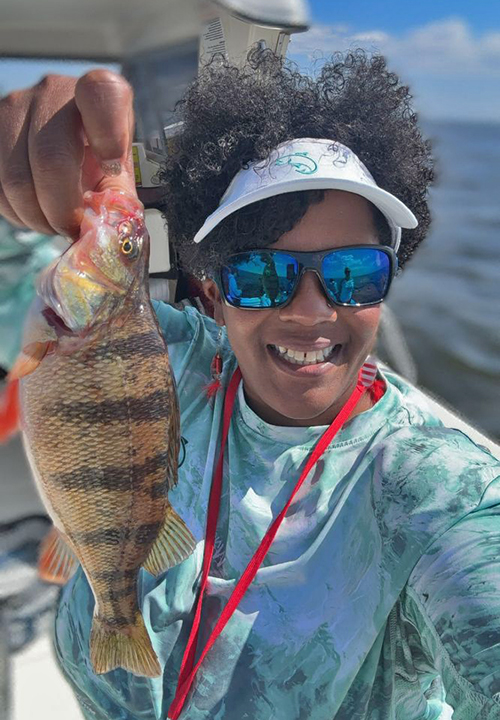 Signs of fall are showing on the Rainy River too. Water temps are cooling, and more bird activity along the river typically means more baitfish are present. Soon, emerald shiners will begin their annual migration into the river, followed closely by big numbers of walleye, what anglers call the fall run. Already, some anglers are boating nice walleyes while targeting the river.
Signs of fall are showing on the Rainy River too. Water temps are cooling, and more bird activity along the river typically means more baitfish are present. Soon, emerald shiners will begin their annual migration into the river, followed closely by big numbers of walleye, what anglers call the fall run. Already, some anglers are boating nice walleyes while targeting the river.
Sturgeon fishing is also picking up, with reports of fish over 60 inches landed this week. As water continues to cool, both the sturgeon and walleye bites will only get better.
Up at the Northwest Angle, fishing remains strong on the Minnesota side of the Angle, with good limits of walleyes being caught. The deep mud of Little Traverse Bay is holding pods of walleyes and saugers, and anglers are finding success by making long drifts or trolling passes to pick off nice eater-sized fish. Jumbo perch and the occasional pike are also showing up in the mix.
Multi-species anglers are enjoying consistent action as well. Muskie anglers are reporting steady activity, and smallmouth bass fishing continues to provide great action around islands, reefs, and rock piles. This weekend marks the annual Buoy Bash Celebration at the Angle. Best of luck to all participants fishing in the Max Multi-Species Fishing Tournament!
Great fall weather and fishing is upon us. Book your fishing trip now!" — Lake of the Woods Tourism, (800) 382-FISH
More Recent Fishing Reports
Follow on X • Follow on Facebook • L.O.W 8-28 • Ely MN 8-27 • Winnibigoshish 8-26 • Perch Fishing 8-25 • Sundin 8-23 • Crappies 8-19 • Spinners 8-15 • Vermilion 08-14 • Wire Spinners 8-12 • Lake Winnie 8-8 • Sundin 8-7 • Northern Pike 7-31 • Bowstring 8-30 • Sundin 7-29 • Grand Rapids 7-28 • Big Sandy 7-27 • Lake Winnie 7-25 • Bemidji 7-21 • Sundin 7-20 • Mille Lacs 7-18 • Sundin 7-17 • Grand Rapids 7-16 • Lake Winnie 7-14 • Sundin 7-11 • Sundin 7-06 • Lake Winnie 7-03 • Walleye Limit 7-01 • Radomski On Walleye Limits • Don't Land A Citation 5-1 • 200 • MN DNR Rule Changes 02-13 • MN Hall of Fame 01-24 • Charts 1-23-25 • MAPS 1-22-23 • Barotrauma Study 1-25-24 • Fish Consumption • Forward Sonar • Panfish Workgroup
 Ely Area, Arrowhead Outdoors Fishing Report August 27, 2025
Ely Area, Arrowhead Outdoors Fishing Report August 27, 2025
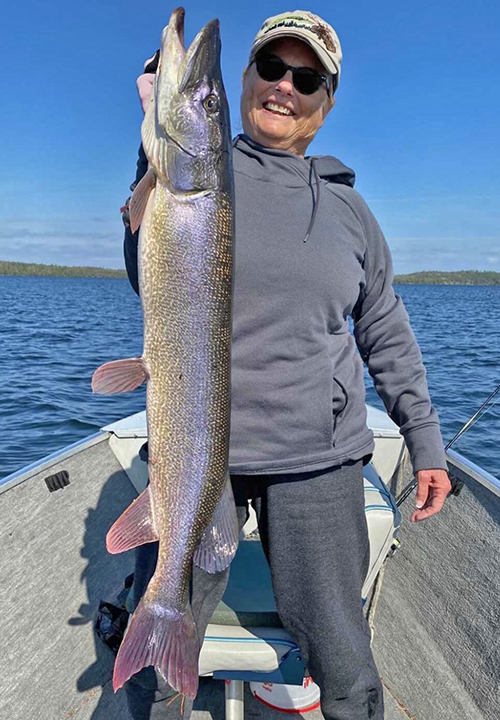 "Northern Pike, some really nice size ones were featured in a handful of pictures that came into the store this last week. As water temps drop down to the magic temperature of 65 degrees, trophy pike will start returning to the shallow weedbeds, river mouths and shallow bays. These big pike are looking for big meals, so large minnow baits, large swim baits, large spoons and big minnows, fished under a bobber are all very effective.
"Northern Pike, some really nice size ones were featured in a handful of pictures that came into the store this last week. As water temps drop down to the magic temperature of 65 degrees, trophy pike will start returning to the shallow weedbeds, river mouths and shallow bays. These big pike are looking for big meals, so large minnow baits, large swim baits, large spoons and big minnows, fished under a bobber are all very effective.
Walleye fishing bounced back quickly last week for walleye anglers. Anglers reported finding walleyes sliding down a little deeper in 14 to 20 feet of water now. Trolling with crankbaits and lindy rigs, tipped with a crawler, has remained the best way to locate active walleyes.
Trolling perch or blue colored crankbaits over large sand or mud flats in 15 to 20 feet of water, preferably on windy areas, remains very consistent. Anglers pulling spinner rigs have been working around sunken islands again in that 14 to 20 foot of water range. Transition areas, in the wind, have been the best areas to focus around humps. Weedlines too, have been effective areas to find walleyes.
Orange, gold and silver have been popular colors for spinner rigs. With water temps dropping a small handful of anglers have been fishing jigs tipped with minnows in these same areas. Success with minnows has been mixed so far, but as we move into September they should start to really pick up.
Smallmouth bass have definitely noticed the drop in water temps and are starting to feed heavily to get ready for winter. Shallow rock piles in 8 to 15 feet of water have been red hot for finding numbers as well as some real giants. Topwater have been very effective on the shallowest rock piles, but for deeper ones anglers have been slow rolling spinnerbaits, chatterbaits and drop shotting their favorite minnow or crawfish imitation. This bite has only started, so expect it to get better and better as we go through September.
Panfish - Crappies and sunfish seemed to have dropped out of the super shallows in search of more stable water temps. Crappies are mainly being found just off weedlines. During the evening hours they slide up to the surface and move into weedbeds to feed. Jig/twister, beetle spins and crappie minnow fished under a bobber can result in some nice catches. Sunfish are being found in 6 to 10 foot deep weedbeds and weedlines. Red worms fished under a bobber in these weedbeds have been deadly!
Stream Trout - Stream Trout have been enjoying the drop in lake temperatures and proof is in the reports. Trolling small minnow baits, over deep water, has been very effective for rainbows. Trolling small trolling spoons too has been very effective for anglers. Best trolling depth has been 10 to 15 feet of water over 30 to 70 feet of water. Anglers fishing from shore have been having great luck floating a night crawler about 2 to 3 feet off the bottom. Nightcrawler fished under a bobber about 5 to 10 feet down, during the evening hours, has also been very effective for shore anglers.
Lake Trout - Reports for lake trout remain scarce this last week. High winds didn't help either, but as water temps start dropping lake trout will start roaming less and start relating to structures like sunken islands and large gravel flats near deep water. As this happens vertical jigging large tubes and bucktails will quickly become the way to go." — Arrowhead Outdoors, 218-365-5358
 Cutfoot Sioux and Lake Winnibigoshish Fishing Report August 26, 2025
Cutfoot Sioux and Lake Winnibigoshish Fishing Report August 26, 2025
 "We’re rolling into the Labor Day holiday weekend and fish migrations into early fall locations have begun. Walleyes are pushing toward shoreline flats, perch are becoming active, panfish and bass are feeding more often, and with greater intensity.
"We’re rolling into the Labor Day holiday weekend and fish migrations into early fall locations have begun. Walleyes are pushing toward shoreline flats, perch are becoming active, panfish and bass are feeding more often, and with greater intensity.
Walleye fishing has been interesting, ranging between very good, and very tough, depending on when our guests try to catch them. When conditions are favorable, like on cloudy, breezy days, they go on the prowl, feeding heavily as they move along shoreline breaks. Common late summer presentations like trolling spinners, wiggle worming and jig and minnow all work well.
But amateurs and pros alike report that calm water, sunshine or post-cold-front conditions grind the daytime action to a halt. Most folks who are fishing during these times report slow going, no matter which presentation they choose.
One way to tip the scales in favor of reliable walleye action is to ..." Read >> Bowen Lodge Lake Winnie Fishing Report August 26, 2025
 Wired2Fish "Top Tactics For Summertime Smallmouth"
Wired2Fish "Top Tactics For Summertime Smallmouth"
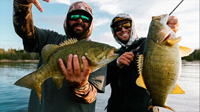 "When anglers think about fishing during the summer months, one word comes to mind: tough!
"When anglers think about fishing during the summer months, one word comes to mind: tough!
Being cool-water fish, smallmouth bass tolerate the warm waters of the summer, but don’t exactly thrive. It’s just that time of year that makes you pull your hair out of your head. They are there in many of the spots you probably know but getting them to bite is like pulling teeth.
So what should you do when the water is 80 degrees and the smallmouth aren’t cooperating? Is there a certain technique that works better than others? Is there a magical depth that they love to hide out in? Summertime smallies can ..." Read Full Story to Learn More >> Top Tactics For Summertime Smallmouth
 August 25, 2025 "Executing the Un-Execute-Able Game Plan"
August 25, 2025 "Executing the Un-Execute-Able Game Plan"
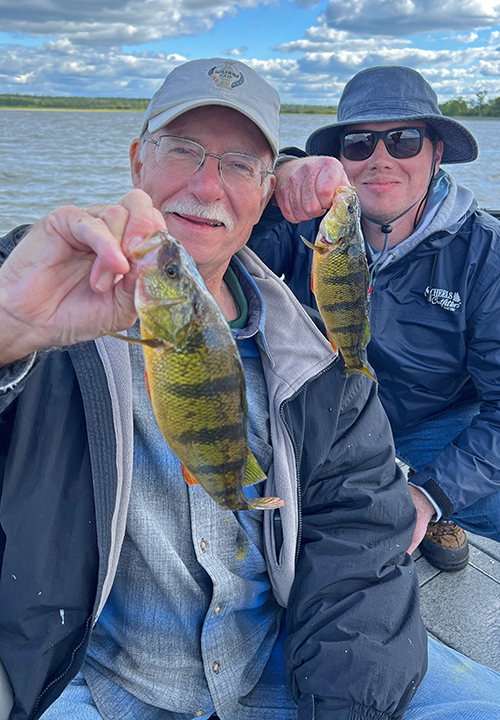 If you work in a bank, and your customer calls you to outline “the plan” for your meeting next Thursday, you probably have a shot at giving her an accurate answer. If your factory produces purple paint, and “your plan” is to produce 1000 gallons of it next Tuesday, there’s a good chance it will happen. But if you work in outside construction, and completing your job depends on favorable weather conditions, it’s not a slam dunk that your project, planned for Friday will come together.
If you work in a bank, and your customer calls you to outline “the plan” for your meeting next Thursday, you probably have a shot at giving her an accurate answer. If your factory produces purple paint, and “your plan” is to produce 1000 gallons of it next Tuesday, there’s a good chance it will happen. But if you work in outside construction, and completing your job depends on favorable weather conditions, it’s not a slam dunk that your project, planned for Friday will come together.
Fishing for a living offers frequent opportunities for planning one thing and then doing another.
Take my charter on Sunday for example, fishing Cass Lake for walleye and perch was the request from my customers. Last week, warm weather and stable conditions made the idea sound do-able. Fish activity was decent, travel conditions on the lake weren’t bad, and there were several fish-able areas to explore. But then, beginning sometime early Saturday morning, Mother Nature delivered a cold front, blown into the region by a strong north-northwest wind. Whitecaps reduced our ability to travel on the lake, plummeting water temperatures decreased fish activity and uncertainty replaced confidence.
“This is one of those day when I’ll need some “luck” if I want to win,” I thought to myself. Then I suggested taking our search to a smaller lake, one where we could move around more easily. With luck, I'd find spots there that would be more manageable, and that offered decent fishing too.
At the lake, water tempertaures had dropped 5 to 6 degrees since last week. Now reading in the upper 60s, after logging in at 75 degrees last week. Whitecaps rolled across the she surface, and the air was chilly. All things consiered though, the lake would be manageable to fish. So, motoring to the north end, hoping for a good start to the day.
After battling the whitecaps on the mid-lake bar for over an hour, our larder included a few low-end keeper perch. We’d been fishing with jigs and minnows, slipping against the current by simultaneously using the drift sock and backing into the waves to create a controlled drift. We released a bunch of little ones, along with a few rock bass and the handful of keepers in our livewell looked pitiful. So far, my “luck”, if you want to call it that, was not holding up very well. Exploring fresh territory on the main lake was going to be both time consuming and uncomfortable, so I decided to try an experiment.
Heading for the calmer, protected shoreline, my “plan” was to cast and retrieve small jigs tipped with minnows toward the shoreline. With “luck”, I’d locate a school of fish that we could work on for a while. The jigs didn’t produce a lot of action, but they did attract a little bit of attention. Perch, decent size ones, hit occasionally, but the sporadic action was still too slow to provide a rewarding experience. “I wonder what will happen if we troll the shoreline with spinners,” I speculated to my crew?
We put way the jigging rods, pulled out the Ugly Sticks and began trolling the shallow water breakline. “Hey, that’s a good one,” Bill said as I reeled in a fat, 11-inch perch. And before long, we had a couple more good ones, along with a couple of small northerns. Long story short, spinners were working, and while the action never got fast, it remained steady for the rest of our trip.
The secret to why fish were there, and the reason for my run of “good luck” was a narrow band of wild celery, aka eelgrass that ran along the shallow water breakline. The depth seemed unimportant provided that there were weeds present. We caught fish as shallow as 3 feet deep, but some were deeper, holding in 5 to 7 feet of water. Again, if the vegetation was present, there were fish in it.
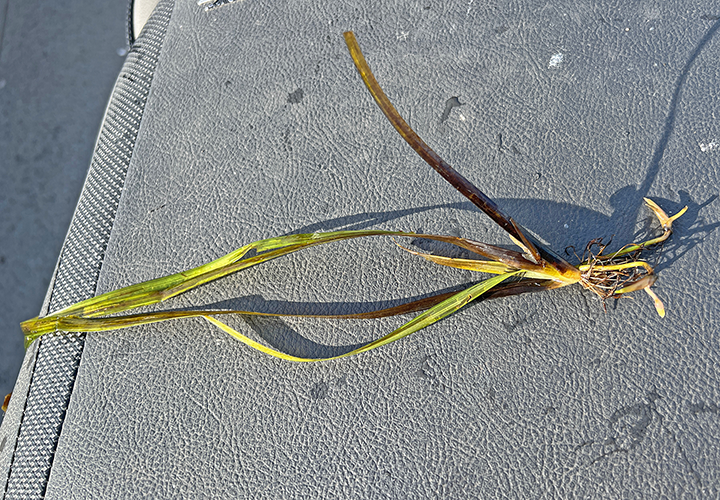 I’m not sure that this location would be good on a calm, sunny day. However, with a chop on the surface, and cloudy skies overhead, the perch, a few northern pike and even a few bonus crappies tolerated the boat passing overhead. On this day, the combination of weather and habitat turned out to be a “lucky” break for me.
I’m not sure that this location would be good on a calm, sunny day. However, with a chop on the surface, and cloudy skies overhead, the perch, a few northern pike and even a few bonus crappies tolerated the boat passing overhead. On this day, the combination of weather and habitat turned out to be a “lucky” break for me.
Walleyes, apparently less tolerant of the boat were in the area too. Located deeper along the breakline in water depths of 18 to 24 feet were easy to see, but hard to catch. Owen did manage to pull one of them into the boat, but the rest of them snubbed our spinners. In the deeper water, small perch were the only fish we could catch.
Overall, the fishing trip was successful, but I don’t want to make it sound better than it was. By days end, we’d harvested 20 decent perch from 9-1/2 inches up to 11-1/2 inches. There were 5 crappies in the livewell, 1 walleye and 4 pike, plus a rock bass that I encouraged the boys to try, just for fun. Along the way, we’d caught a lot of smaller perch, pike an rock bass and that made the action seem busy. Obviously, this still wasn’t the trip of a lifetime, but on a blustery day, the action was good enough to put smiles on our faces.
The lack of walleyes was a disappointment, but I fish with Bill and Owen again today so we’re hoping to fix that problem on a smaller, Bemidji area lake. Whatever happens there, I’ll report tomorrow. ![]() — Jeff Sundin, The Early Bird Fishing Guide Office Cell Call or Text 218-245-9858 or Email on Facebook on X
— Jeff Sundin, The Early Bird Fishing Guide Office Cell Call or Text 218-245-9858 or Email on Facebook on X
 August 23, 2025 "Northern Pike Locations and Presentations"
August 23, 2025 "Northern Pike Locations and Presentations"
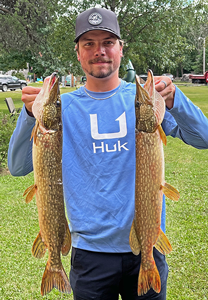 Every summer I get requests to chase Northern Pike and for me, that’s great, I love them. This week, I spent a few days with customers who wanted pike, and for the most part, it worked out. There were times when fishing was not fast, but there were times when it was. There were times when the fish were large, but then again, there were times when they were. So, the overall combination of quality, action and harvestability was what I’d call decent.
Every summer I get requests to chase Northern Pike and for me, that’s great, I love them. This week, I spent a few days with customers who wanted pike, and for the most part, it worked out. There were times when fishing was not fast, but there were times when it was. There were times when the fish were large, but then again, there were times when they were. So, the overall combination of quality, action and harvestability was what I’d call decent.
One observation that you may have already made is that the fish pictured in this report are fairly long, but not very fatty. While the fish we’ve harvested this week have generally been in good health, they have obviously not been feeding a lot. The stomachs of every fish that we’ve harvested this week were empty, not even a morsel of undigested food in them. Warm water stress, a condition that affects pike, is to blame I think, and I’ll come back to that topic again in future reports.
In a nutshell, finding pike, especially quality pike, can sometimes depend on finding areas of cooler water. One way to do this is to fish lakes that have desirable deep-water habitat for pike. Another is to fish lakes that have good stands of leafy vegetation like cabbage, plants that provide shade, along with open patches where pike, when they’re feeding, can ambush forage. Avoiding shallow, warm water lakes that have dense mats of weeds should be avoided for the time being.
For me, steep breaklines that straddle the line between deep water and cabbage weeds has been the best location. Key depths have ranged from 14 to 22 feet, but I’ve spotted some fish holding in deeper water too. That has forced us to use presentations that run deeper, like jigs tipped with light pike sucker minnows. The jig-minnow combos, I think overall, have been the best way to trigger the most strikes.
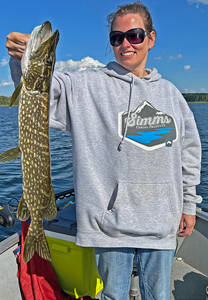 Jigs, ¼ ounce size with large, long shank hooks tipped with 4-inch paddle tails has been a close 2nd. For folks who are “good” at fishing with the artificial tails, casting and retrieving the swim baits with a fast fall-sweep-fall-sweep motion has worked well. Tolling spinners has worked too, but we’ve had to use heavier weights to keep the spinners running deeper. This means that they snag in the weeds more and can be tedious at times. That said, for folks who struggle with jigging presentations, trolling spinners tipped with shiners, or small pike suckers has been effective and remains a highly rated presentation.
Jigs, ¼ ounce size with large, long shank hooks tipped with 4-inch paddle tails has been a close 2nd. For folks who are “good” at fishing with the artificial tails, casting and retrieving the swim baits with a fast fall-sweep-fall-sweep motion has worked well. Tolling spinners has worked too, but we’ve had to use heavier weights to keep the spinners running deeper. This means that they snag in the weeds more and can be tedious at times. That said, for folks who struggle with jigging presentations, trolling spinners tipped with shiners, or small pike suckers has been effective and remains a highly rated presentation.
A while back, (August 15, 2025) I shared a tip about using 65-pound test power pro braided line for tying spinners. One reader of the Fishing Reports Minnesota Facebook page wrote, “Braid is not clevis friendly as it can break (filament-by-filament) until it fails. Monofilament, fluorocarbon and v coated wire is what to want for blade rigs like the one in the photo advice.”
I agree with that comment, but recall, in the original article, the suggestion is to avoid using folded metal clevises. I recommended that folks use plastic, quick change type clevis to cut down on the fraying of braided lines. For me, 17-pound test fluorocarbon has been the standard for tying spinners over the past few years. This week, we’ve used both fluorocarbon and power pro braid and I have to say that the power pro, overall, has been better than the fluorocarbon in terms of pike bite offs. While we’ve lost several spinners tied on fluorocarbon, only one of the power pro rigs has been lost.
That doesn’t mean that I haven’t had to re-tie any of them, I have, but that’s the point of using them. When the only intended purpose is to reduce the frequency of bite offs by northern pike, longevity of the individual spinner rig is not the issue. Sooner or later, it will need to be replaced, or re-tied, no matter what line material is used. The point is that the braid can help us save the valuable components, allowing us to re-tie, rather than replace the entire rig.
Specific questions are always welcome, and I’ve outlined some fairly specific circumstances. I think if you’re chasing pike this week, but fish on a lake where my location, or presentation tips are not useful, let me know. I’ll be happy to offer some alternative ideas for lakes that have differing habitats than those I described here. ![]() — Jeff Sundin, The Early Bird Fishing Guide Office Cell Call or Text 218-245-9858 or Email on Facebook on X
— Jeff Sundin, The Early Bird Fishing Guide Office Cell Call or Text 218-245-9858 or Email on Facebook on X
 Lake of the Woods, LOW Tourism August 20, 2025
Lake of the Woods, LOW Tourism August 20, 2025
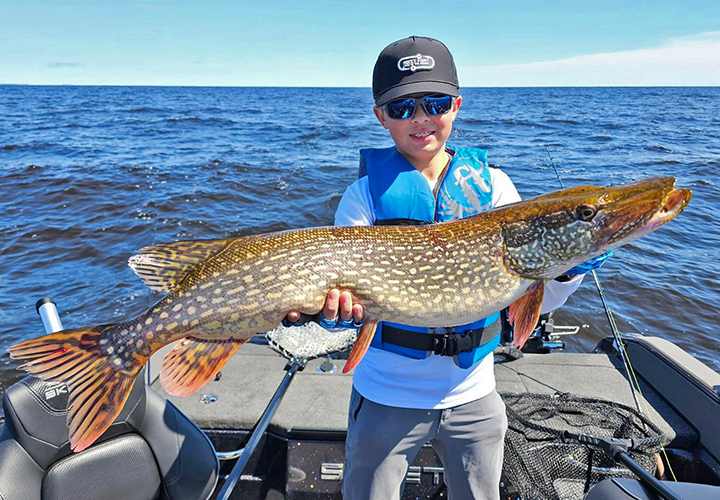 "The late-summer walleye bite continues to shine on Big Traverse Bay, on the south end of Lake of the Woods. Fishing has been excellent, with big numbers of walleyes holding over the deep mud basin in 31 to 34 feet of water. Anglers are finding success with two main techniques:
"The late-summer walleye bite continues to shine on Big Traverse Bay, on the south end of Lake of the Woods. Fishing has been excellent, with big numbers of walleyes holding over the deep mud basin in 31 to 34 feet of water. Anglers are finding success with two main techniques:
Drifting or trolling crawler harnesses – two- and three-hook rigs tipped with crawlers are producing well. Some anglers are also using minnows, with a minnow on each hook or even a minnow on one and a piece of crawler on the other. Productive blade colors this week include gold, pink, orange, chartreuse, and firetiger. Don’t be afraid to go heavy with your bottom bouncer—up to 3 ounces—to maintain a 45-degree angle and stay near the bottom.
Trolling crankbaits – another go-to tactic right now. Lead core, snap weights, or bottom bouncers with a shallow-diving crankbait are all helping anglers reach the right depths where the schools of walleyes are feeding.
The action has been steady, and many anglers are reporting limits of eaters along with memorable fish in the slot and even a few trophies. On days where walleyes get a bit sluggish, speeding things up with crankbaits has been helpful.
On the Rainy River. The Rainy River continues to provide a mixed bag of action. Walleye fishing is stable, meaning the river in the summer has resident fish with fish spread along current breaks, holes, and shoreline structure. Certainly good fish to be had, but you have to work for them. In addition to walleyes, anglers are hooking into sturgeon, pike, smallmouth bass, and even a few crappies. The river is a great option when winds are up on the big lake.
As early as early to mid September, emerald shiners from the lake will start entering the river pulling in numbers of walleyes which will continue to ice up. This is what they call the "fall run".
Up at the Northwest Angle, fishing remains excellent on both the US and Canadian sides of the border. U.S. side – Targeting the deep mud of Little Traverse Bay with spinners or crankbaits continues to be effective. Much like Big Traverse Bay, deep mud is holding good fish. Walleyes are also relating to rock-to-mud transitions, and some anglers are finding success jigging these areas.
Ontario side – Walleyes are being caught by pulling spinners or jigging with frozen emerald shiners or minnows in 12–28 feet of water. Areas of deep mud adjacent to rock holding fish. As is often the case, structure, points and neck down areas with current have been reliable locations.
The Angle continues to produce not only good numbers of walleyes but also strong multi-species action, including smallmouth bass, crappies, pike, and even muskie activity around the islands.
Water Conditions. Lake water temperatures are slowly starting to cool, currently holding around 69°F. As late summer transitions into fall, fishing patterns will shift, but for now, anglers are enjoying some of the best action of the year." — Lake of the Woods Tourism, (800) 382-FISH
 News Release "Mille Lacs Lake walleye limit increases from 2 to 3 on August 23, 2025"
News Release "Mille Lacs Lake walleye limit increases from 2 to 3 on August 23, 2025"
 "The walleye limit on Mille Lacs Lake will increase from two to three beginning Saturday, Aug. 23, and continuing through Sunday, Nov. 30. The size limit — which allows anglers to harvest fish 17 inches or longer but only one longer than 20 inches — remains in place.
"The walleye limit on Mille Lacs Lake will increase from two to three beginning Saturday, Aug. 23, and continuing through Sunday, Nov. 30. The size limit — which allows anglers to harvest fish 17 inches or longer but only one longer than 20 inches — remains in place.
“Our primary management objective is to maintain a healthy walleye population and remain within the state’s share of sustainable harvest,” said Brad Parsons, Minnesota Department of Natural Resources fisheries section manager.
“The slow bite this year allows the DNR to meet that primary goal and offer anglers the chance to take home an extra fish during the ..." Read News Release >> Lake Mille Lacs Walleye Limit Increase August 20, 2025
 Ely Area, Arrowhead Outdoors Fishing Report August 20, 2025
Ely Area, Arrowhead Outdoors Fishing Report August 20, 2025
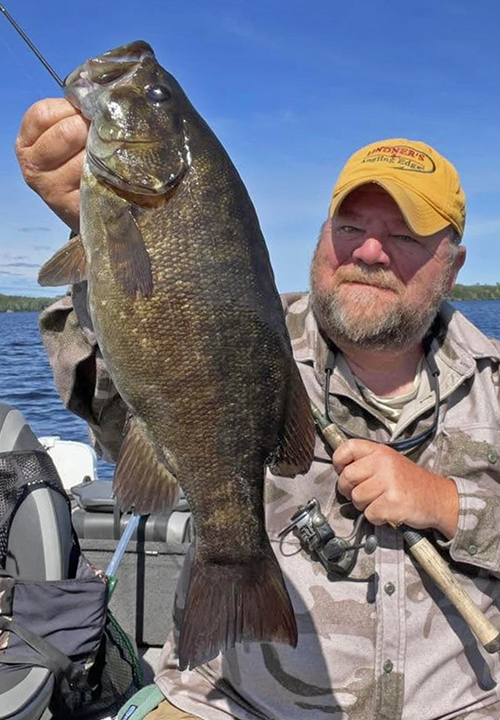 "Walleye - Fall like cold snap has really shut down the walleye bite in the Ely area. Anglers have been reporting that they are seeing walleye's sitting in 10 to 15 feet of water, but are struggling to get them to bite. Oftentimes, if they strike, they just hold on to the baits, unwilling to eat the bait.
"Walleye - Fall like cold snap has really shut down the walleye bite in the Ely area. Anglers have been reporting that they are seeing walleye's sitting in 10 to 15 feet of water, but are struggling to get them to bite. Oftentimes, if they strike, they just hold on to the baits, unwilling to eat the bait.
Covering water, looking for biters is more important than ever right now. Trolling with leadcore, coving ground, is where the best reports were this last week. Anglers have been trolling in 12 to 20 feet of water with perch colored crankbaits over large sand and mud flats. Unable to troll? Well, fishing crawlers on lindy rigs or 1/4 ounce jig and half a crawler, along windy shorelines, preferably shorelines with rocks. Remember walleyes are not very active, so be sure to give walleyes some time to eat your presentation before setting the hook. Gold, black/org, and orange/chart, have been the most productive colors.
Smallmouth Bass anglers too noticed a drop in big bass coming into the boat this last week too. Reports of small bass being active were very common. Early morning topwater bite has cooled off for many. Spinnerbaits, in-line spinners, chatterbaits and wacky worms continued to produce fish, but again on the small side for the Ely area. Many anglers reported 8 to 12 feet being the best depth to find bass.
Northern Pike enjoy cooler water temps so it makes sense that good pike reports have been coming, especially during this cold snap. Anglers have been reporting they are catching quality size pike with large swimbaits, large spoons and buzzbaits. Weedbeds, mouths of shallow bays and around current areas have been very productive.
Panfish - Sudden drop in water temps knocked the majority of crappies and sunfish out of the shallows and into a little deeper water where they find warmer, stable water temps. Both crappies and sunfish dropped out to 12 to 18 feet of water, along deeper weedlines. Small red worms, fished close to the bottom, at the base of weedlines was the most productive way to catch them.
Crappies on the other hand were more suspended about 8 to 12 feet below the surface. Small beetle spins and jig/twister swam slowly along these depths, during the evening hours was the best way to catch a few crappies.
Stream Trout - Many savvy anglers knew stream trout also enjoy this kind of weather so they went trout fishing. Trolling small trolling spoons and small crankbaits, about 10 feet down, produced good numbers of stream trout. Anglers fishing from the bank reported good luck casting small spinners, floating a night crawler off the bottom or under a bobber about 10 feet below the surface." — Arrowhead Outdoors, 218-365-5358
 August 19, 2025 "You Can't Catch Crappies In De-Nial"
August 19, 2025 "You Can't Catch Crappies In De-Nial"
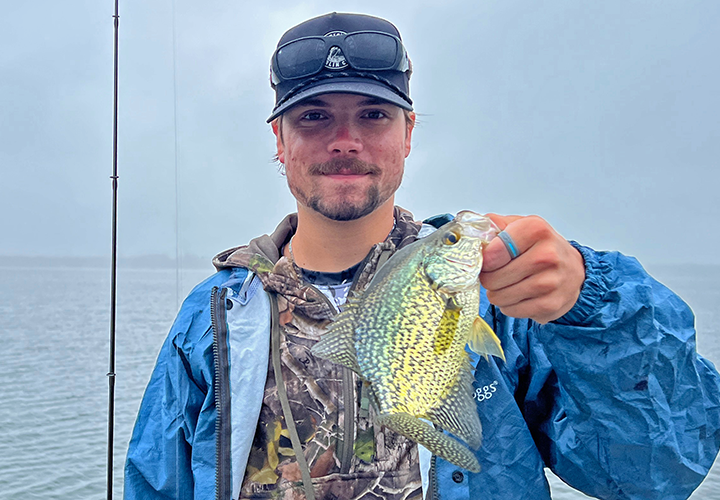 At first, I thought I had arrived too early in the season for the fish. My thinking was, “I’ll find them next time. If I just wait another week or 10 days, and then try again, then I’ll find them in their usual late summer haunts.” So, I waited, maybe a couple of weeks, and I went back to try again. This time was a bust too, we caught walleyes, and other assorted fish too. But the crappies, despite my best search efforts, were still not there.
At first, I thought I had arrived too early in the season for the fish. My thinking was, “I’ll find them next time. If I just wait another week or 10 days, and then try again, then I’ll find them in their usual late summer haunts.” So, I waited, maybe a couple of weeks, and I went back to try again. This time was a bust too, we caught walleyes, and other assorted fish too. But the crappies, despite my best search efforts, were still not there.
Now I’m wondering, what’s wrong with those fish, why haven’t they shown up in their summer territory yet? More concerned than before, but still confident that they would show up eventually. “I’ll just be patient and wait them out, sooner or later, they’re gonna show up” I reasoned.
Sometime along the way, I had a call from a prospective customer whose goal it was to figure out where the crappies, in mid-August, would be located. He and his family over the years have caught lots of crappies on the popular Deer River area lake. In recent years, crappies have become more elusive, and hopefully, I could shed light on alternative locations. Always up for a challenge, I accepted the charter but offered an advisory that I hadn’t been fishing in the lake recently. Also, I let them know that I would be coming on the heels of a weeklong vacation to Lake Vermillion.
“That’s okay, said my customer, what we really want do is learn some techniques for locating the lake’s crappies when they’re in deeper water. Maybe the fish are not on the shoreline during summertime like they used to be.”
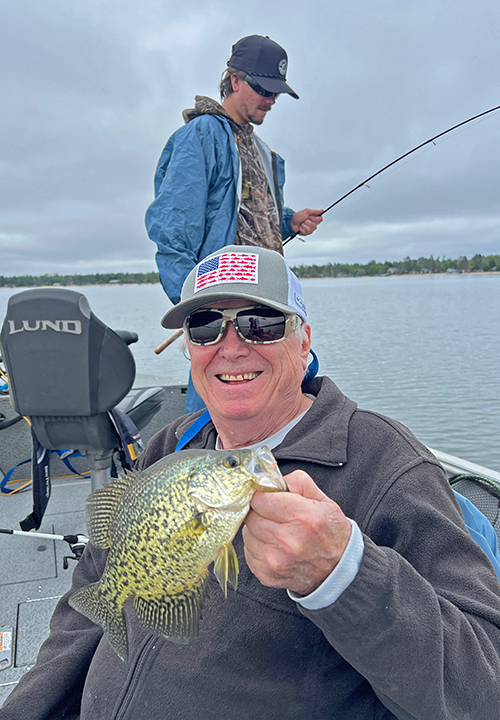 You may recall that the vacation to Lake Vermillion with the Hippie Chick fell apart last week. We decided to use the windfall of free time to experiment with crappie locations on the lake, maybe I could get a head start on the crappy location project. So, we scheduled a day to search for crappies and either find them, or at least rule all the places not to go with my customers on their fishing date.
You may recall that the vacation to Lake Vermillion with the Hippie Chick fell apart last week. We decided to use the windfall of free time to experiment with crappie locations on the lake, maybe I could get a head start on the crappy location project. So, we scheduled a day to search for crappies and either find them, or at least rule all the places not to go with my customers on their fishing date.
When Susan and I arrived at the lake, our first stop was at one of the more popular late summer crappy locations. The flat consisted of scattered rocks mixed with some weeds and historically, has been a consistent mid-summer producer for me. On the first trolling pass, I caught a nice crappie, and we saw another one caught by a couple who were fishing nearby. “It looks like maybe we’re finally onto something,” I thought to myself. But after fishing there, along with a dozen other spots for the next 6 hours, we came up with exactly 0 more crappies.
Okay, now this is starting to get frustrating. I’ve checked many of the more popular spots and I’ve checked some obscure ones, and I’ve even checked some totally off-the-wall spots to boot. I am concerned, but I’ve already agreed to take the charter, and like I said, I’m not one to back down from a challenge. So, Sunday arrives, I meet my customers at the dock of their resort, and we start our fishing trip. We all have high hopes that within the allotted half-day trip, I will figure out where to go, and how to catch some crappies. In the end though, we would end up with another day of crappie-less fishing.
Now, I’m driving to my next charter, and reflecting on the reasons for my failure. My thought is that I am losing touch with whatever I thought I knew about fishing for crappies on that lake. “I guess I’m gonna have to figure it all out again, starting from scratch.” I think. Then it dawns on me, I'm just in denial, I can't catch fish if they're not there.
There was a similar situation for me a few years back, you might remember reading about it. At the time, I waited patiently for crappies to show up in their fall habitats on Cutfoot Sioux. The timing was getting later and later, but still the crappies simply were never showing up. Meanwhile I’m seeing random reports from area anglers, most of whom I didn’t know, and those folks indicated that they were catching crappies like crazy on other area lakes. The common thread was that crappies were in classic fall patterns, the fish were being taken from typical fall locations, using typical fall presentations.
Once I abandoned Cutfoot, and began searching for other, new to me lakes, crappie fishing became easy again. The alternative lakes provided fish, in that case, that were easy to locate, and easy to catch. I already knew what I needed to know, and for me, there was no reason to learn new techniques of searching for fish in obscure locations. I didn’t need to learn any new presentations either, the fish in fresh territory reacted favorably to the most common presentations.
In the words of a friend, fisheries biologist and outdoor writer Dick Sternberg, “A good spot, is a good spot. When there are fish in the lake, then the good spots will have fish on them. When you can’t find them, you must be suspicious that they’re just not in the lake.”
Okay, fast forward to my fishing charter yesterday, August 18, 2025. My customers want to catch crappies, and they’re 40 miles west of the lake where I fished on Sunday. Skeptical about the activity level of the crappies, I drove toward Bemidji with my fingers crossed, hopeful that I could work out of my little crappie “slump”.
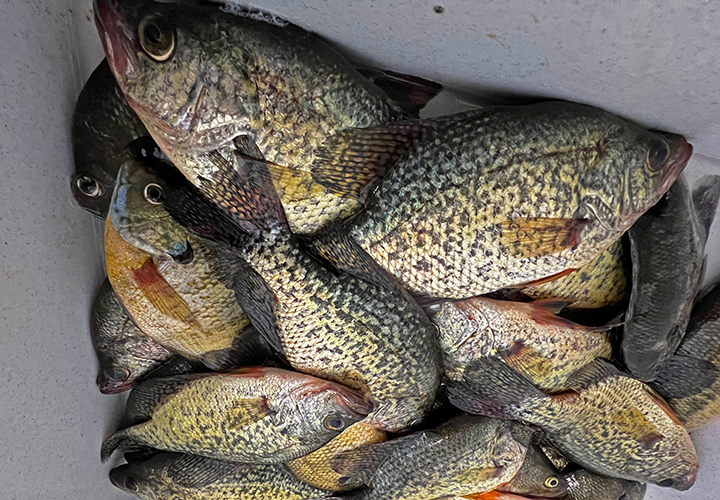 Long story short, the crappies were more than cooperative, and their locations presented few surprises. Some classic late summer locations like weed beds, inside corners along the shoreline, and points leading into deep water all held fish. Key depths ranged between 9 and 12 feet of water, and occasionally, there were isolated schools of fish in 14 to 16 feet, just outside the weed edges.
Long story short, the crappies were more than cooperative, and their locations presented few surprises. Some classic late summer locations like weed beds, inside corners along the shoreline, and points leading into deep water all held fish. Key depths ranged between 9 and 12 feet of water, and occasionally, there were isolated schools of fish in 14 to 16 feet, just outside the weed edges.
Presentations, like trolling spinners and tight-lining jigs tipped with minnows both worked. So did suspending jigs tipped with plastic tails below clip on bobbers. Whenever there were fish present, common presentations and common locations provided fish. In the end, we left the lake with 2 limits of crappies, along with a handful of bonus fish that we stumbled into along the way.
Driving home last night, I’m reflecting on the experiences, and I reminded myself that in Sternberg’s words, “a good spot is a good spot.” But the pre-requisite for finding a good fishing spot is to locate a lake that has a sufficient population of the species we want to target. Proven again this week, if there are fish in the lake, there will be fish on the lake’s “good spots”.
We know that crappie populations are naturally prone to fluctuations, cycling between strong year classes, and poor ones. We know too that crappie anglers add to the fluctuations, we tend to find fish and catch them, working the stock down to the point where a lake is seemingly: “fished out.” Although a lake is never completely emptied of all crappies, populations can get so low that finding them becomes a daunting task. Catching them becomes harder too because low populations of well fed fish can be extremely choosy about when, where and what they will eat.
We know that populations fluctuate, and we know that finding good fishing depends on avoiding lakes that have been fished hard and locating alternatives that haven’t. One question is how do we figure out when our favorite lake needs to be left behind in favor of finding new territory? Another question is how do we figure out where that “fresh territory” will be?
The documentation of crappie populations is sketchy at best. Fisheries surveys are infrequent, and crappies are notoriously hard to catch in test nets. Fisheries information is often outdated and because of their sporadic spawning cycles, can have gaps that last several years. Until now, the only way I can find the better lakes has been to fish them. I may try 3 lakes to find one good one, sometimes maybe more. So, my project now is to try and figure out if there is a way to predict which lakes have good potential, and which ones don’t.
For guidance, I reached out to some reliable sources, experts on panfish and fish biology who might shed light on the situation. I hope you’ll follow the story as it unfolds and if you have ideas of your own, I hope you will reach out to share your thoughts. Often, the key to getting a good answer is to ask a good question, and if you have one, I’d love to know that too. ![]() — Jeff Sundin, The Early Bird Fishing Guide Office Cell Call or Text 218-245-9858 or Email on Facebook on X
— Jeff Sundin, The Early Bird Fishing Guide Office Cell Call or Text 218-245-9858 or Email on Facebook on X
 Reader Comments August 18, 2025 "Big Sandy Lake Success Story"
Reader Comments August 18, 2025 "Big Sandy Lake Success Story"
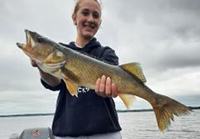 On August 17, 2025 Dan Hamilton Reported; "Saturday morning dawned rainy and cool. We finally hit the water at about 11am with overcast skies.
On August 17, 2025 Dan Hamilton Reported; "Saturday morning dawned rainy and cool. We finally hit the water at about 11am with overcast skies.
We started on a chain of submerged humps not far from the Army Corp of Engineers campground at the Sandy Lake Recreation Area. We pulled spinners over the tops in 12 feet of water with no bites. Then we moved out to the mud/rock transition in 25 feet of water where we hooked a few small northern pike, a 12 inch crappie, and one small walleye.
We decided to fall back on our old stand by presenatation of pulling Rapala Husky Jerks in 6 to 8 feet of water along the wind blown shore lines. As we worked along island shore lines in a south easterly direction, we picked up a few more small walleye and northern pike. When we approahed the area near Battle Point, Isla hooked into something big and that's where she brought this 26 inch walleye to the boat. After a few pictures and a quick trip across the bump board, this big girl was gently placed back into Big Sandy for some one else to catch.
I think we did okay for a first visit. The Army Corp campground is a nice facility and I like having the dock at the camp site. There is a lot more lake for us to explore, we will probably be back." Dan Hamilton
 Reader Comments August 15, 2025 "More on Bite-Off Protection From Toothy Critters"
Reader Comments August 15, 2025 "More on Bite-Off Protection From Toothy Critters"
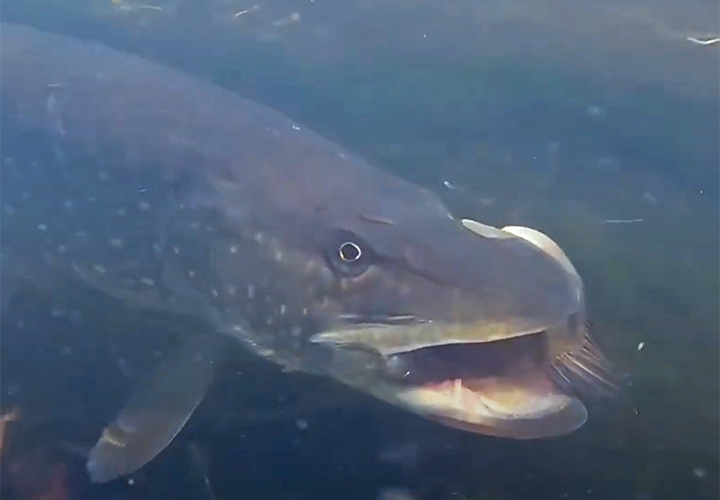 Sean Moran wrote, “Hi Jeff, I'm writing in response to your article on reader comments on August 12, 2025. For years, my extended family has enjoyed trolling with spinners tipped with white Mister Twister tails for pike and walleye in the mid-summer season. It's shocking how well it works sometimes, even without any live bait!
Sean Moran wrote, “Hi Jeff, I'm writing in response to your article on reader comments on August 12, 2025. For years, my extended family has enjoyed trolling with spinners tipped with white Mister Twister tails for pike and walleye in the mid-summer season. It's shocking how well it works sometimes, even without any live bait!
We went through a stage where we thought it was better to use braided line like Roy Girtz as you had mentioned. It did seem to cut down on "bite off" from northern pike. However, we found that the clevis that the spinner rides on would eventually wear into the braided line and fray it, leading to break offs.
Years ago, I worked at a sporting goods store, and I found a spool of 80-pound test Billfisher mono fishing leader material that is meant for saltwater fishing in a sale bin. It was difficult to tie, but also crystal clear and would eliminate all bite-off. I now know the proper way to "tie" that material is to use metal crimps.
Eventually, I settled on a leader material called TrikFish Fluorocarbon in the 50 pound test weight. It's still tie-able, it's invisible in the water, and it will eliminate 99.99 % of the bite-offs from northern pike.
Thanks for all the great fishing reports! Sean Moran
On 2025-08-12 14:27, Daniel Hamilton wrote: “A few years ago, I experimented with wire and found we had issues with it kinking and affecting the spinner action. I tried braided lines and still had bite offs but it was not the higher test stuff you mentioned (in the August 12, 2025, article). So, I might revisit this option.
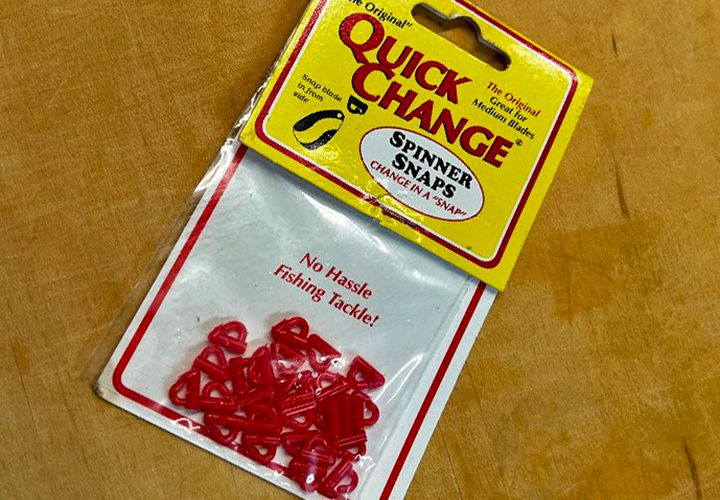 I switched over to Seagur Blue Label fluorocarbon in 25-pound test. We haven't lost scissor lips since. We do have fish come to the boat where the harness is damaged to the point it needs to be replaced. The parts get saved for reuse. I tie 6 to 8 dozen harnesses every winter. Beads are usually red/chart, red, chart or blue. I use quick change clevises.
I switched over to Seagur Blue Label fluorocarbon in 25-pound test. We haven't lost scissor lips since. We do have fish come to the boat where the harness is damaged to the point it needs to be replaced. The parts get saved for reuse. I tie 6 to 8 dozen harnesses every winter. Beads are usually red/chart, red, chart or blue. I use quick change clevises.
Our most productive blade color is hex gold, rusty chartreuse was good on the river this spring too, northland pink baitfish has been good on the Duluth area reservoirs lately.
Another setup we use comes from Michigan. It's called a mayfly rig, made of a single gold #4 hook, 6- 4mm gold beads and a small gold blade. Tip with a crawler smidgen or a small leech. Works well when fish are on a mayfly binge.
One of the reasons I like fishing the St Louis is on the Wisconsin side a person is allowed 3 lines. With 3 people in the boat, on a large flat we run 4 boards off each side and one line down the chute. This gives us the opportunity to try a wide variety of spinner combinations in a short amount of time.
Thank you both for the helpful fishing tips, your fellow anglers will benefit from your guidance. Sean, like you, I learned to use the wire crimping method to make leaders. In the 1980s and 90s, using flexible wire, crimped directly to jig heads was a popular way for walleye and bass anglers to protect from bite offs from unwanted pike attacks.
The introduction, and subsequent improvements of fluorocarbon fishing lines made the crimping process less desirable. Fluorocarbon is easy to tie, and while it is not 100% effective in stopping bite-offs, it does, like Dan said, protect against most of them. My sense is that Dan, like me, values the spinner components, and being able to re-use them when the leaders become frayed, is the main benefit of using the fluorocarbon leaders.
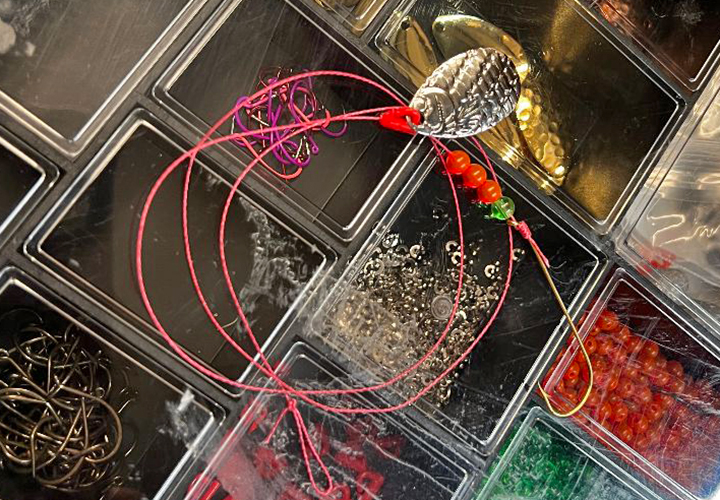 Regarding fraying of braided lines caused by friction from the spinner clevis’, I’m thinking that the specific type and brand of braided line should be taken into consideration. The clevis used should be considered too. An inexpensive, mass-produced clevis, sometimes stamped with worn edges from worn out machines, may be more problematic than higher quality products.
Regarding fraying of braided lines caused by friction from the spinner clevis’, I’m thinking that the specific type and brand of braided line should be taken into consideration. The clevis used should be considered too. An inexpensive, mass-produced clevis, sometimes stamped with worn edges from worn out machines, may be more problematic than higher quality products.
The “quick change” style plastic clevis’ that Dan mentioned are likely a good idea here too, the plastic causes less friction than metal stamped ones. Again, the benefit of using the braided line, theoretically, is not that are infalable. Rather, the benefit is that they will last long enough to detect wear and tear, allowing us to retain the original parts so we can re-tie our spinners occasionally.
Like Dan, in the early days of their introduction, I tried braided lines to make leaders and found that they did not prevent bite-offs from pike at all. In fact, many of the early versions I tried were actually more prone to damage than the heavy monofilament offerings that were available at the time. Because of those experiences, I was skeptical about re-visiting braided line to tie spinners. So far though, I’m happily surprised, since I’ve been using the spinners tied on 65-pound Power Pro (pictured left), about 2 weeks now, I have not lost a spinner yet. The experiment is ongoing, and I’ll be eager to share more results as I gain experience using it.
Finally, I can see your point Dan about using multiple rods and being able to experiment with a variety of spinners, colors and leader combinations. I guess I don’t know what I’m missing because fishing inland lakes of Minnesota, I’ve never been able to use more than one rod at a time. Somehow, we still figure out what works, but I can appreciate that speeding up the process must be nice.
You Are Invited To Become A Duly Deputized Fishrapper Cub Reporter Too!
 If you've been waiting for a gold engraved invitation to participate in the daily reports, then stop waiting and consider this your own personal invitation.
If you've been waiting for a gold engraved invitation to participate in the daily reports, then stop waiting and consider this your own personal invitation.
Helping your fellow fishermen and women stay abreast of fishing conditions in your area is good for everybody and it's easier than you think! You don't have to write a book, you don't have to share your secret fishing spots and you don't even have to mention your lake. You see, with just a few words about general trends, seasonal patterns or local weather conditions you can help steer your fellow anglers to more gratifying fishing experiences. So, be like Dan and Sean, and become a duly deputized "Cub Reporter", it's good for fishing and that's good for everybody!
Use the Contact Us page, or if you prefer to be "social", use our community page on facebook Fishing Reports Minnesota, that is the Facebook counterpart to this page and it is open to the public, so you can post your own fishing update or just share a photo of a nice catch.
 August 14, 2025 "The Happy Camper-Less's Visit Lake Vermilion"
August 14, 2025 "The Happy Camper-Less's Visit Lake Vermilion"
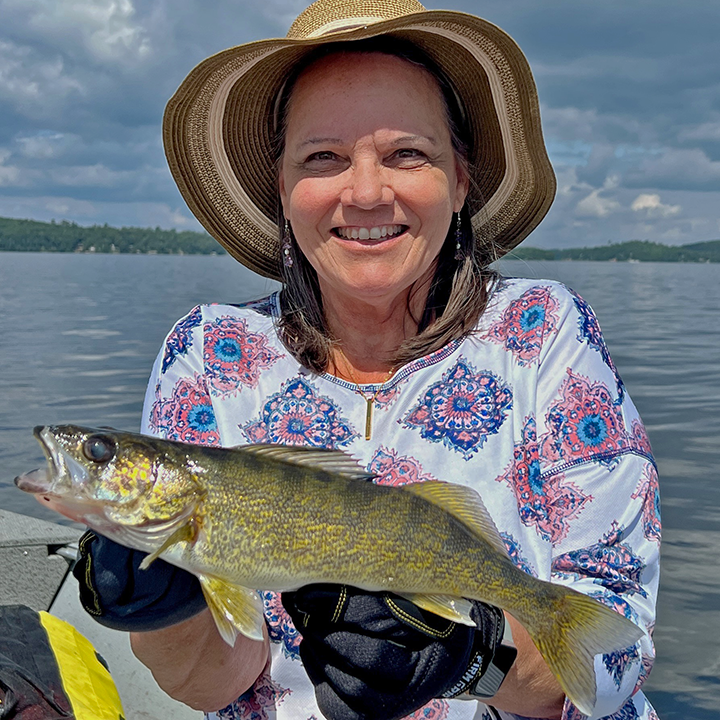 You may not have had first experience with Murphy’s Law, adjunct #81717; “No vacation based on wedding anniversary date may be completed as planned.” I and Susan have though, several times now.
You may not have had first experience with Murphy’s Law, adjunct #81717; “No vacation based on wedding anniversary date may be completed as planned.” I and Susan have though, several times now.
You see, celebrating our wedding anniversary has become my excuse for taking mini vacations during the summer. While we always wind up doing something fun, it seems like every time we make special plans to go away, some part of the plan falls apart. This summer, our plan to spend the week camping at Lake Vermilion was short circuited by vehicle problems. On Sunday, we made it as far as Hibbing, about 30 miles, before we were forced to turn back home.
Lost but not forgotten, was “the plan” to fish on Lake vermilion. We’d already cleaned the boat, prepared the fishing gear, studied the maps and learned about some “new” techniques. Excited about the forecast of nice weather for Wednesday, a day trip to fish the 40,000-acre lake became the new, abbreviated plan. So, we headed up early yesterday morning.
At the landing, we were greeted by sunshine, moderate air temperatures and calm surface conditions. The clear, but coffee colored water was 76 degrees, and that temperature would be consistent everywhere we traveled throughout the day.
There was a significant insect hatch going on, Midge, the mosquito-looking flying bugs that don’t bite, but do land and crawl around on everything, including the human body. They were plentiful, and innocently annoying, serving as the only reminder that this was not heaven. On the other hand, the hatching midges provided an important clue about fish location. Bloodworms, the larval form of midge flies can be found feeding on organic material in soft bottom, marl areas of the lake. The bloodworms attract all sorts of minnows, tiny gamefish and adult perch. The food chain that sets up then attracts larger gamefish, like walleyes.
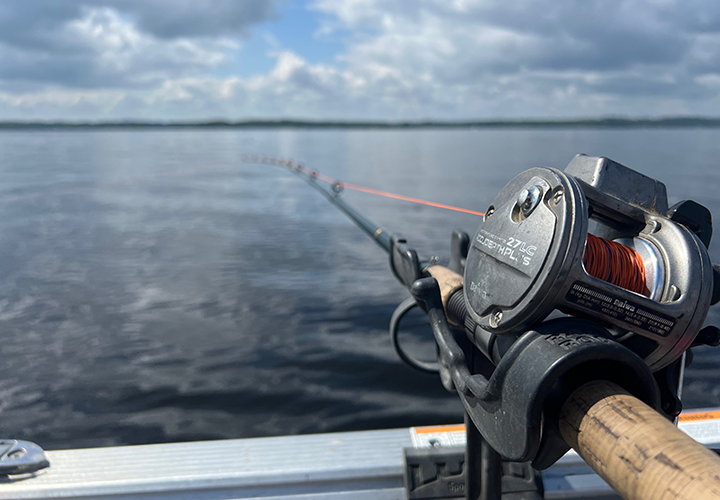 Ordinarily, I would have preferred fishing with a breeze, which would have helped keep the bugs off of us, and probably would have made the fishing better too. But on this day, the calm water really helped make exploration easy. We were able to travel freely from spot to spot, watching the graph for signs of fish, and/or fishy looking structures. After a short search, we began spotting fish near the breaklines where sandy flats met the lake’s deeper, main basin.
Ordinarily, I would have preferred fishing with a breeze, which would have helped keep the bugs off of us, and probably would have made the fishing better too. But on this day, the calm water really helped make exploration easy. We were able to travel freely from spot to spot, watching the graph for signs of fish, and/or fishy looking structures. After a short search, we began spotting fish near the breaklines where sandy flats met the lake’s deeper, main basin.
Trolling crankbaits was once a preferred presentation for me but lately has fallen out of favor. We’d learned from friends though that trolling crankbaits is high on the list of preferred presentations on Vermilion. So, for this trip, I dusted off the trolling rods and packed up most of the crankbait boxes I could find in the garage.
It didn’t take long to see why trolling presentations are popular on Lake Vermilion. The walleye, like the one you see on the screen of my graph pictured here, were found as singles, doubles, or occasionally formed tiny “pods” of 3 to 5 fish that were spread horizontally along the breaks, or on top of the flats. Covering water, lots of it, and quickly, is one of the most productive ways to get a meal of walleyes for the family.
We had rods rigged and ready to fish either shallow or deep depending on the fish locations. Seeing them in water depths of 20 to 23 feet, the lead-core rods were the ones we put into service. Trolling with lead-core line might sound complicated, but it isn’t. Just think of the line, multi-colored braided Dacron with a thin strand of lead in its center, as a sinker. The more of the sinking line you let out, the deeper your lures will go. Each color is about 30 feet long, and one color sinks the line to about 5 or 6 feet deep.
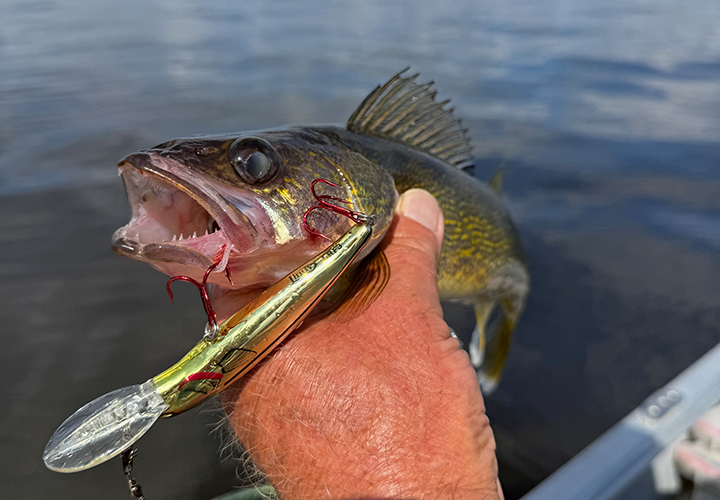 The crankbaits themselves have their own running depths too, so some experimentation is needed. To catch fish at 22 feet deep, an angler could start with lures that dive about 6 feet deep, and then let out about “3 colors”, or about 90 feet of line. If the lures bounce on the bottom, then shorten up the line a little bit, if they never touch the bottom, let out a little bit more, and so on. Once the depth is “dialed in” precise control of the lures running depth makes this system highly efficient.
The crankbaits themselves have their own running depths too, so some experimentation is needed. To catch fish at 22 feet deep, an angler could start with lures that dive about 6 feet deep, and then let out about “3 colors”, or about 90 feet of line. If the lures bounce on the bottom, then shorten up the line a little bit, if they never touch the bottom, let out a little bit more, and so on. Once the depth is “dialed in” precise control of the lures running depth makes this system highly efficient.
Back in my days working with Lindy, a Pradco brand, I accumulated a lot of crankbaits that were closely based on models of other popular Pradco items. So since I have a lot of crank baits already, it would have been silly of me to go out and buy more. This means that the baits we preferred yesterday would now be considered obsolete. The lures we used, Lindy’s Rally Fish, pictured, were based on some of the Bandit line of crankbaits. If I wanted more lures like the Rally Fish that worked well for us, I’d search within the Bandit lineup to find them.
There are so many good lures out there that almost everybody already has something that will work. So for you, I’d suggest also starting with the lures you already have in your tackle box. Salmo, Rebel, Rapala, Bandit, Cotton Cordel and others, have wide arrays of walleye catching crankbaits. An angler might find one that appears to be “the best” one on a given day, but I’d be amazed to find lures that never work at all. Again, this is the benefit of using the lead core line, almost any lure can be kept in the proper fish catching depths.
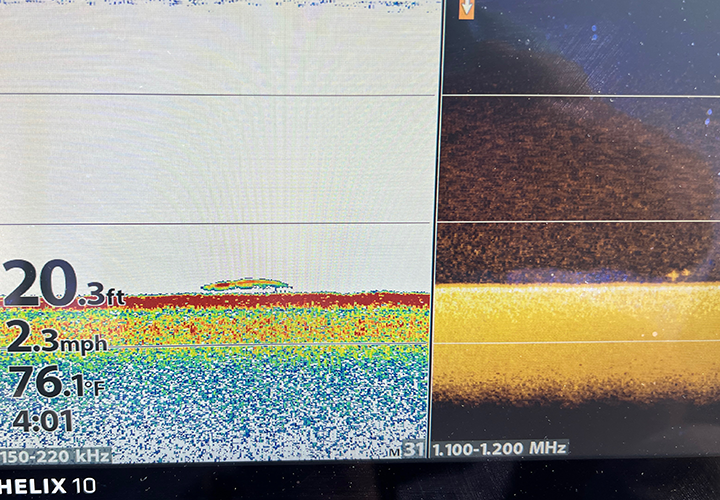 Speaking of depths, there were times yesterday when I saw fish in deeper water. For me, avoiding those fish is a priority, so whenever we saw fish deeper than about 24 feet, we simply did not attempt to catch them. Admittedly, there are situations where you have to go where the fish are if you want to catch them. And if your only goal is to catch and harvest “eaters” and there is no likelihood of releasing any fish, then the fishing depth becomes irrelevant. However, when there is a protected slot limit, like the 20-to-26-inch protection range on Lake Vermilion, it would be wise to avoid fishing in deeper waters.
Speaking of depths, there were times yesterday when I saw fish in deeper water. For me, avoiding those fish is a priority, so whenever we saw fish deeper than about 24 feet, we simply did not attempt to catch them. Admittedly, there are situations where you have to go where the fish are if you want to catch them. And if your only goal is to catch and harvest “eaters” and there is no likelihood of releasing any fish, then the fishing depth becomes irrelevant. However, when there is a protected slot limit, like the 20-to-26-inch protection range on Lake Vermilion, it would be wise to avoid fishing in deeper waters.
For us, trolling crankbaits was the only presentation required. We observed some other anglers on the lake who caught fish using spinners too. Without anything more than casual sightings, I can’t describe the specifics about their presentations. But I’d try spinners too, if I was fishing in the same areas again today, but we won’t be there.
Although I’m technically still on vacation, my brain is already beginning to think about work. The Hippie Chick and I will likely try fishing waters closer to my usual service territory. We might go out later today, but first I need to pressure wash my boat to get rid of the icky stuff from yesterday’s excursion.
Spiny Water Fleas, an invasive species found in Lake Vermilion are bad news, and the last thing I want is to bring them home with me. Bleach will kill the adults, but it won’t get rid of the eggs, if there are any present in my boat. Hot water, over 140 degrees, is really the only way to get rid of them, or Zebra Mussels, or Faucet Snails, or whatever other critters we have floating around here these days. So, before we can go anywhere, I’ll need to get the full cleanup treatment. ![]() — Jeff Sundin, The Early Bird Fishing Guide Office Cell Call or Text 218-245-9858 or Email on Facebook on X
— Jeff Sundin, The Early Bird Fishing Guide Office Cell Call or Text 218-245-9858 or Email on Facebook on X
 Wired2Fish "Freshwater Fishing at a Crossroads: Balancing Access and Conservation"
Wired2Fish "Freshwater Fishing at a Crossroads: Balancing Access and Conservation"
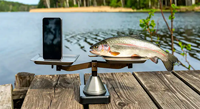 "From the tranquil lakes of the Northwoods to the winding rivers of the South, freshwater fishing remains a defining part of the American outdoors. It’s more than a sport — it’s a tradition, a family ritual, and, for many, a vital part of rural economies. But today, freshwater fishing stands at a critical crossroads.
"From the tranquil lakes of the Northwoods to the winding rivers of the South, freshwater fishing remains a defining part of the American outdoors. It’s more than a sport — it’s a tradition, a family ritual, and, for many, a vital part of rural economies. But today, freshwater fishing stands at a critical crossroads.
Across the country, state fish and wildlife agencies are reevaluating management strategies in response to environmental change, habitat degradation, and increasing pressure on popular game species like largemouth bass, trout, and crappie. Warmer winters and unpredictable rainfall are altering fish behavior and spawning patterns, while invasive species — like zebra mussels and Asian carp — are reshaping ecosystems at alarming rates.
In response, some states ..." Read Full Story to Learn More >> Freshwater Fishing at a Crossroads: Balancing Access and Conservation
 Lake of the Woods, LOW Tourism August 13, 2025
Lake of the Woods, LOW Tourism August 13, 2025
 "On the South End of Lake of the Woods, in Big Traverse Bay, walleye fishing is on fire this week. With the deep mud basin holding huge numbers of fish, there are reports from anglers and guides that have been nothing short of glowing. Saying things like, “We have been drifting for 3 hours and are still catching walleyes”, “(This is) some of the best walleye fishing we have ever had.” and "The kids really enjoyed catching a good number of slot fish with an occasional trophy.”
"On the South End of Lake of the Woods, in Big Traverse Bay, walleye fishing is on fire this week. With the deep mud basin holding huge numbers of fish, there are reports from anglers and guides that have been nothing short of glowing. Saying things like, “We have been drifting for 3 hours and are still catching walleyes”, “(This is) some of the best walleye fishing we have ever had.” and "The kids really enjoyed catching a good number of slot fish with an occasional trophy.”
Most of the action is taking place in 32 to 34 feet of water, where large schools of walleyes are roaming. These fish are aggressive, and both primary techniques, pulling spinners and trolling crankbaits are putting plenty of gold in the boat.
For spinners, most anglers are running a two- or three-hook harness tipped with a crawler. Some have switched it up with frozen emerald shiners on the spinner, with excellent results. In these depths, don’t be shy about using a 3-ounce bottom bouncer to maintain a solid 45-degree line angle and keep your presentation near bottom. Spinner colors, gold/red, gold/chartreuse, orange, firetiger, gold/pink.
Trolling crankbaits has also been lights-out. While some charters are running downriggers, many anglers are using more common approaches such as leadcore line, snap weights, or pairing a 4-ounce bottom bouncer with 6 feet of mono or fluorocarbon leader and a shallow-diving crankbait. All of these will get your lure down to where the walleyes are feeding.
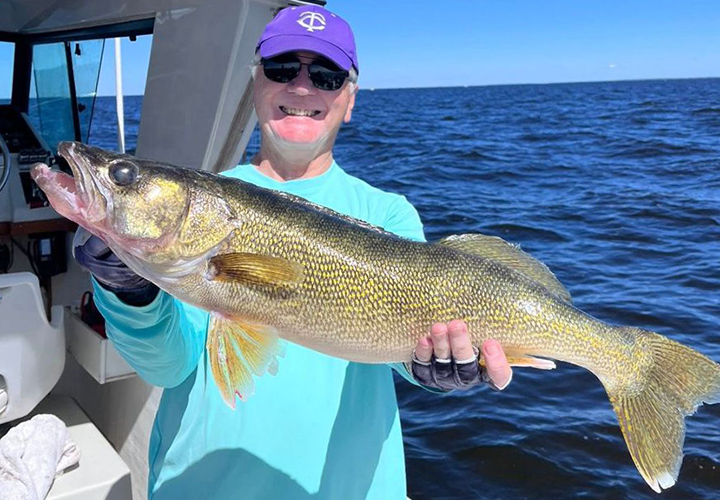 On the Rainy River, water clarity has improved recently, and walleye action has picked up. The river is producing a true mixed bag—walleyes, sturgeon, smallmouth bass, northern pike, and even some crappies. Sturgeon anglers are reporting plenty of action, with lots of smaller fish in the mix. Remember, the keep season is open; anglers with a tag may keep one sturgeon per calendar year 45 to 50 inches or over 75 inches.
On the Rainy River, water clarity has improved recently, and walleye action has picked up. The river is producing a true mixed bag—walleyes, sturgeon, smallmouth bass, northern pike, and even some crappies. Sturgeon anglers are reporting plenty of action, with lots of smaller fish in the mix. Remember, the keep season is open; anglers with a tag may keep one sturgeon per calendar year 45 to 50 inches or over 75 inches.
Up at the Northwest Angle. both the Minnesota and Ontario sides are producing good numbers of walleyes. Around the islands, jigging, pulling spinners, and trolling crankbaits are all catching fish. Like the south end, the NW Angle offers a great multispecies opportunity, strong smallmouth bass fishing, active northern pike, and some crappies in the mix. Muskie anglers are also seeing consistent action throughout the islands, with multiple follows and hookups being reported.
Plan Your Trip: Whether you’re looking for a limit of eaters, a chance at a trophy walleye, or a multispecies adventure, now is the time to be on Lake of the Woods. Lodging, charters, and guides are available. The bite is hot, the scenery is unbeatable, and with the lake fishing this well, you might just land your personal best.
New Resource: Real-Time Wave Buoy Data on Lake of the Woods helps anglers and boaters make informed decisions before heading out. Locations include: Big Traverse Bay West, Big Traverse Bay East, Northwest Angle. Check wave heights anytime here at Lake of the Woods Wave Height Buoys — Lake of the Woods Tourism, (800) 382-FISH
 Ely Area, Arrowhead Outdoors Fishing Report August 13, 2025
Ely Area, Arrowhead Outdoors Fishing Report August 13, 2025
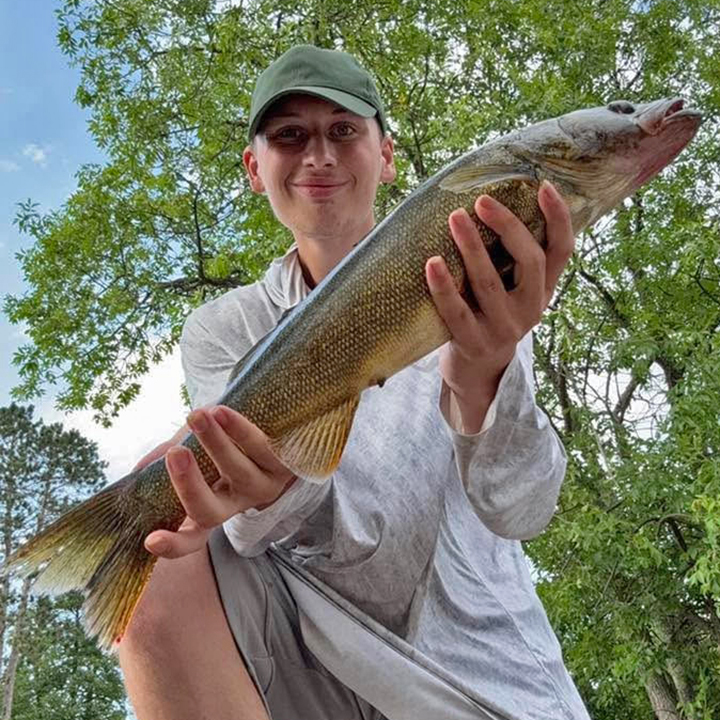 "Walleye - Heavy rains accompanied by lots of lightning, over the weekend, has thrown a wrench into the shallow water bite and walleye bite overall. As the dust settles and walleye bite gets going again angling reports are finding walleyes out in deeper water, 15 to 30 feet of water is where anglers are finding walleyes now.
"Walleye - Heavy rains accompanied by lots of lightning, over the weekend, has thrown a wrench into the shallow water bite and walleye bite overall. As the dust settles and walleye bite gets going again angling reports are finding walleyes out in deeper water, 15 to 30 feet of water is where anglers are finding walleyes now.
Trolling large crankbaits with leadcore has been very consistent over large sand or mud flats. Perch, blue and black/silver have been popular colors here. Trolling not your thing? Anglers have also been catching walleyes with lindy rigs or jigs around main lake points and sunken islands in the same depth range. Anglers have been using leeches, crawlers and larger minnows here. Gold, black/orange and pink have remained popular colors.
Smallmouth bass also slowed up, especially for the big bass. Topwater bite has cooled off some, but has been improving. Best topwater bite remains early in the mornings along shorelines, large shallow flats and river mouths. If you're a fan of largemouth bass, fishing frogs in thick lily pads and wild rice beds have been phenomenal this last week. This bite is great early in the mornings too, but often continues throughout the day. Once the sun gets up and the topwater bite cools off, anglers have been switching to wacky worms, spinnerbaits, chatterbaits and square bills in order to keep catching fish.
Panfish - Heavy rains also seemed to of knocked panfish out of the super shallow waters and into a little deeper water for now. Sunfish and crappies have both moved out to weedlines now. Red worms and small leeches, fished under a bobber on weedlines and just inside weedbeds has been very effective for sunfish.
While crappies have moved to the outside weedlines, the depth they are being caught remains very shallow. Anglers are reporting they are catching the majority of their crappies 1 to 2 feet under the surface using small beetle spins, jig/twisters or thumper jigs. Last hour of light has been by far the best time to catch crappies.
Northern Pike on the other hand seem to enjoy cloudy rainy days and cooler weather. Lots of quality pike were reported over the weekend by many anglers. Buzzbaits and the new X-Rap Otus have been very effective on quality pike. Deep weedbeds, mouths of shallow bays and river mouths are the areas to focus on for pike.
Stream trout anglers continue to catch good numbers of trout this last week. Anglers have been simply trolling small brightly colored minnow baits or small trolling spoons to catch trout. Anglers only need to get their baits down to about 10ft and simply troll until they find active trout. Once found, simply keep trolling through the area.
Lake trout - Small handful of lake trout reports came in this last week. Anglers are catching trout 30 to 50 feet down over 50 to 100 feet of water. Large trolling spoons were the most common bait used to catch lakers." — Arrowhead Outdoors, 218-365-5358
 Brainerd MN Area Fishing Report August 13, 2025
Brainerd MN Area Fishing Report August 13, 2025
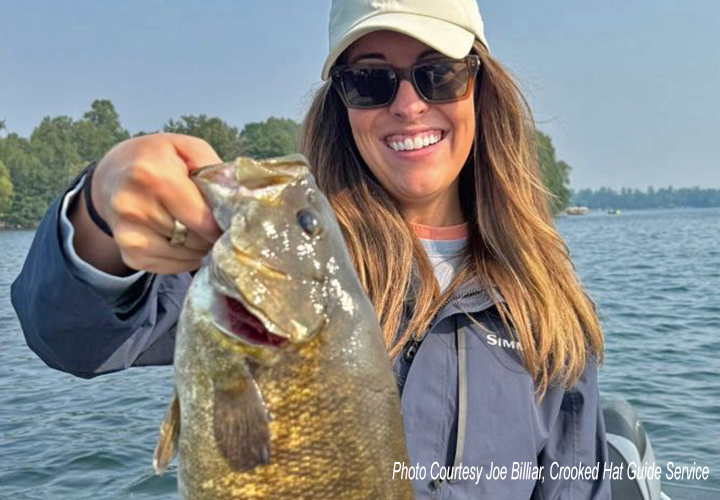 "The dog days or summer are in effect here in the Brainerd lakes region, but the action remains steady.
"The dog days or summer are in effect here in the Brainerd lakes region, but the action remains steady.
Walleyes continue to be taken on jigs and crawlers or bobbers with leeches/crawlers. Weedlines and mid lake humps are currently holding the best pods of walleyes. Morning and evening have been best times to fish, however some anglers report that fishing during midday has also been productive.
The bass bite is on fire right now. Smallmouth bass are coming from mid depth-deep rocks. Drop shots, Ned rigs, and bobbers are hard to beat. Largemouth bass are holding weedlines and biting just about everything right now. Go-to baits are spinners, ned rigs, and bobbers.
Muskies have been moving on bucktails up shallow or bulldawgs out deeper. Good luck and tight lines." — Joe Billiar, Crooked Hat Guide Service • 507-469-2714
 Reader Comments August 12, 2025 "Steel Leader Spinners Northern pike"
Reader Comments August 12, 2025 "Steel Leader Spinners Northern pike"
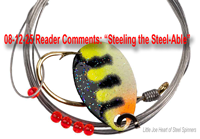 Throughout time, anglers have sought to figure out the best way to keep northern pike from biting off their favorite fishing lures. The question is whether steel leaders, likely the best way to prevent attacks by pesky “scissor bills” can still be effective for finesse presentations, and for catching sight feeding fish like walleye, smallmouth bas and sunfish.
Throughout time, anglers have sought to figure out the best way to keep northern pike from biting off their favorite fishing lures. The question is whether steel leaders, likely the best way to prevent attacks by pesky “scissor bills” can still be effective for finesse presentations, and for catching sight feeding fish like walleye, smallmouth bas and sunfish.
The debate is settled for one reader, Richard Rush, who on August 11, 2025, wrote; “Hello Jeff, Just returned from our weeklong trip in Longville area. Although the walleye bite was tough (we don't care about walleye anyhow) there were still some neat developments on the northern pike front.
Rush reported catching a lot of northern pike, some of them in the low 20+ inch keeper size range, as well as some pike that fell within the protected slot size range. The problem, Rush’s fishing party got bit off several times by northern pike, including a larger one that snapped off a Little Joe Spinner at boatside. Rush, “In conversations with our elder statesman, my 76-year-old dad, he recommended that we ..." Read Full Report >> August 12, 2025 Steel, Fluorocarbon and Braid Leaders For Northern Pike
 August 10, 2025 "Guaranteeing the Guarantee-Able"
August 10, 2025 "Guaranteeing the Guarantee-Able"
 I get a lot of questions and comments from folks who are planning their fishing trips. Commonly, they’ll follow similar themes like “I want to be sure my trip is worth the long drive.” Or “I don’t want to come when my favorite species isn’t biting.” Or maybe, “I want to be sure that my favorite seasonal pattern will be in full swing when I get there.”
I get a lot of questions and comments from folks who are planning their fishing trips. Commonly, they’ll follow similar themes like “I want to be sure my trip is worth the long drive.” Or “I don’t want to come when my favorite species isn’t biting.” Or maybe, “I want to be sure that my favorite seasonal pattern will be in full swing when I get there.”
They ask questions to help zero in at the right time to plan their trips too. Maybe I’ll get an email asking something along the lines of “When is the best time to fish Lake Wishiknew? Or What’s the best month to catch walleyes? Or maybe, when can I find crappies in shallow water? When you boil it all down, the underlying question is this. How can I get guaranteed results that I’ll catch my preferred target species on my next fishing trip?
The answer is easy, just plan your trip so that the weather will be perfect for catching your target species.
How the heck am I supposed to do that, you’re asking? Well, I’m not sure, as hard as I try, predicting future weather patterns, especially long-range patterns, just isn’t working out for me. This year especially, the weather forecast always seems to be off, sometimes a little, sometimes a lot. So, what I do know for sure is that there is no way to guarantee any fishing trip will come together perfectly as planned.
Here’s something else I know for sure, if you’re willing to go with the flow, there is almost always something biting. Anybody who loves catching fish can catch fish if they’re not “stuck” on the idea of pursuing any single “target species” of fish. Let me give you some examples from the past week.
One day, the target species was crappies, but the sunshine and calm water had them hunkered down in heavy weeds. Instead of catching crappies, we discovered that the sunfish were on fire. So, we spent the afternoon catching them and sorting out a nice bag of good-looking bluegills. The very next day, not even 18 hours later, the Hippie Chick and I drove our daughter and grandson over to the same lake, hoping to get in on the sunfish action. Guess what, we hardly caught any bluegills, but it was cloudy and breezy so this time the crappies were on fire! We didn’t harvest any of them, but we could have brought home a bunch of nice ones, if we needed them.
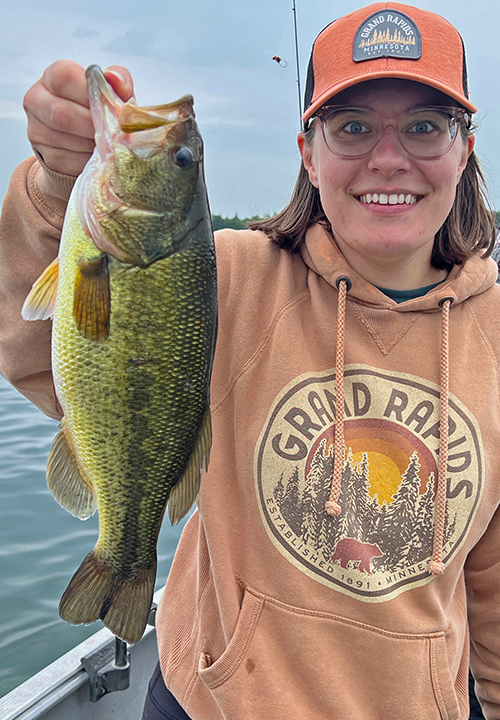 On Thursday, my charter customers wanted to fish on Lake Winnie. I gathered reports from friends, and a couple of other fishing guides were fishing out there and they agreed, walleye fishing had been great there on Wednesday. There was wind, and fish were on the prowl, catching walleyes was no problem for anybody. On Thursday though, the sunshine and calm water gave Winnie walleyes a major case of lockjaw. Catching them was a huge problem for everybody. For me, trolling the heaviest winds I could find yielded some perch and pike, but no walleyes.
On Thursday, my charter customers wanted to fish on Lake Winnie. I gathered reports from friends, and a couple of other fishing guides were fishing out there and they agreed, walleye fishing had been great there on Wednesday. There was wind, and fish were on the prowl, catching walleyes was no problem for anybody. On Thursday though, the sunshine and calm water gave Winnie walleyes a major case of lockjaw. Catching them was a huge problem for everybody. For me, trolling the heaviest winds I could find yielded some perch and pike, but no walleyes.
At midday, the wind started blowing, and there was a chop on the water. I decided to get back into the search for walleyes, but not long after that, the wind went calm again. Long story short, we never did find the walleyes. My mistake was leaving the weeds and going back out into “walleye territory” when I could have simply stayed in the weeds catching whatever would bite. In the end, we would all have been happier, but looking back, I didn’t know that at the time.
Fast rewind to yesterday when I fished with the Parrish family. Remember the crappie and sunfish lake I mentioned? After a rain delay in the morning, it seemed like the perfect way to squeeze in a quick trip to a small lake. If the crappies weren’t biting, we’d get sunfish, or vice versa, I reasoned. Guess what, this time the panfish bite was off and neither sunfish nor crappies were cooperative. I got lucky though because this time the largemouth bass were on fire, and the kids loved it! I can’t say how many, but we caught a lot, and they pulled hard, and everybody was smiling.
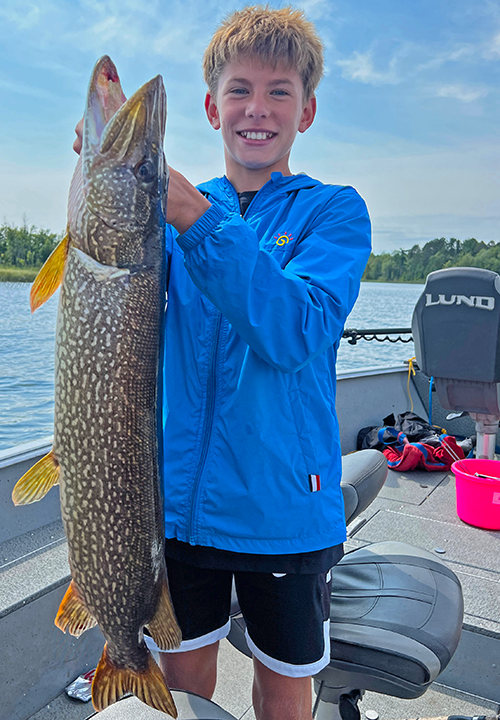 There were some northern pike biting too and as a bonus, Ty Parrish caught the beautiful Esox lucius that you see pictured here. This one, a very solid fish in the 12-to-15-pound range made the whole family smile.
There were some northern pike biting too and as a bonus, Ty Parrish caught the beautiful Esox lucius that you see pictured here. This one, a very solid fish in the 12-to-15-pound range made the whole family smile.
The results of some other trips have been less cut and dried. Sometimes we catch some of what we’re looking for, along with some of what we’re not looking for. Sometimes, we’ve caught the right fish, but they were the wrong size, protected slot-walleyes for example, or bass that were deemed too big to be tasty for harvesting and the like. On those days, alternative species have kept us busy and for the most part, our fishing days have ended happily.
The point of today’s report is, I guess, that we shouldn’t lose sight of the joy that comes from fishing itself. Whenever we’re willing to roll with punches and catch whatever bites, we wind up being happy. But whenever we put too much emphasis on the “ideal plan” and fight against Mother Nature’s influences, we wind up being “less happy”.
There is absolutely no harm in planning a fishing trip around a preferred target species, or around a specific seasonal pattern we like. But sometimes we lose sight of the fact that we’re lucky to be catching anything at all. Fishing is always “worth it” even on the days when the plan doesn’t come together. The conversation, the scenery, the knowledge that comes from pursuing your target, it all adds up.
Knowing that Mother Nature does not offer warranty service on fishing trips, it’s a good idea to figure out alternative plans for those days when things don’t come together quite right. When we remember this, unexpected highlights, like young Mr. Ty Parrish’s’ northern pike just seem to come along as a reward. Don’t ask me why, it just seems to happen that way. ![]() — Jeff Sundin, The Early Bird Fishing Guide Office Cell Call or Text 218-245-9858 or Email on Facebook on X
— Jeff Sundin, The Early Bird Fishing Guide Office Cell Call or Text 218-245-9858 or Email on Facebook on X
 Cutfoot Sioux and Lake Winnibigoshish Fishing Report August 8, 2025
Cutfoot Sioux and Lake Winnibigoshish Fishing Report August 8, 2025
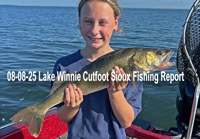 "During prime time, walleyes go on the prowl and get all the food they need in short, intense feeding bursts. With stomachs full of food, walleyes simply sit out the periods when conditions do not favor productive feeding. This helps explain why it can be easy to view fish on electronics, but difficult to tease them into striking.
"During prime time, walleyes go on the prowl and get all the food they need in short, intense feeding bursts. With stomachs full of food, walleyes simply sit out the periods when conditions do not favor productive feeding. This helps explain why it can be easy to view fish on electronics, but difficult to tease them into striking.
Folks who have fished Winnie for a long time know that this situation is about to change.
With every day that passes, predators consume more baitfish. Insect hatches run their course too, further reducing the available food supplies. Sometime during the next few weeks, reduced food supplies, combined with the early influences of fall will begin shifting the balance. More walleyes will compete for less food, and they will ..." Read Full Report >> Bowen Lodge Lake Winnie Fishing Report August 8, 2025
 August 7, 2025 "Can You Tell Us the Name of That Crappie Lure?"
August 7, 2025 "Can You Tell Us the Name of That Crappie Lure?"
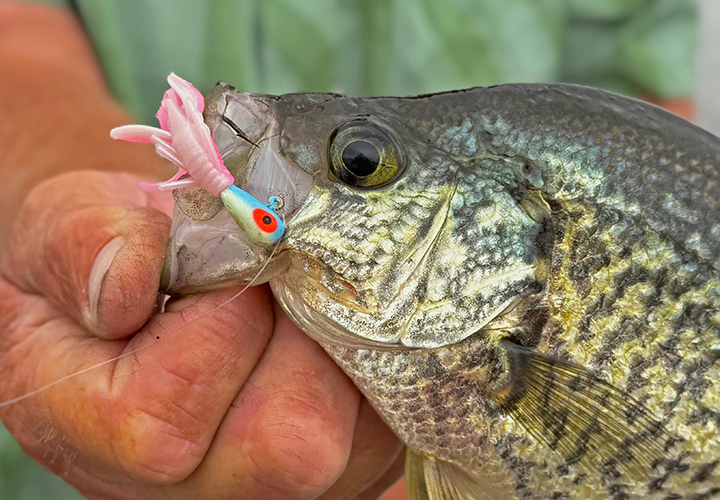 Q) Owen Gunderson wrote, “Hey Jeff, thank you for the fantastic, in-depth reports, I read them all. I think you meant to tell us which crappie lure you were using last Saturday, (see full report August 4, 2025) but inadvertently left out the name. My question is, will you please provide the name of that lure you were using?”
Q) Owen Gunderson wrote, “Hey Jeff, thank you for the fantastic, in-depth reports, I read them all. I think you meant to tell us which crappie lure you were using last Saturday, (see full report August 4, 2025) but inadvertently left out the name. My question is, will you please provide the name of that lure you were using?”
A) Owen, thank you both the vote of confidence and the question. You’re right, in my haste to get the report published and out the door for work, I did forget to fill in the blank about the plastic tails we used to catch those crappies. The lure, Berkely’s 1 inch (2 CM) Power Nymph on a 1/8-ounce Lindy Live Bait is what you see pictured here. On of my fishing customers turned me on to the power nymph a couple of years ago, and it’s been a very reliable panfish lure for me ever since. For crappies, I’ve used the pink/pearl color, for sunfish, the brown/orange color has worked well too.
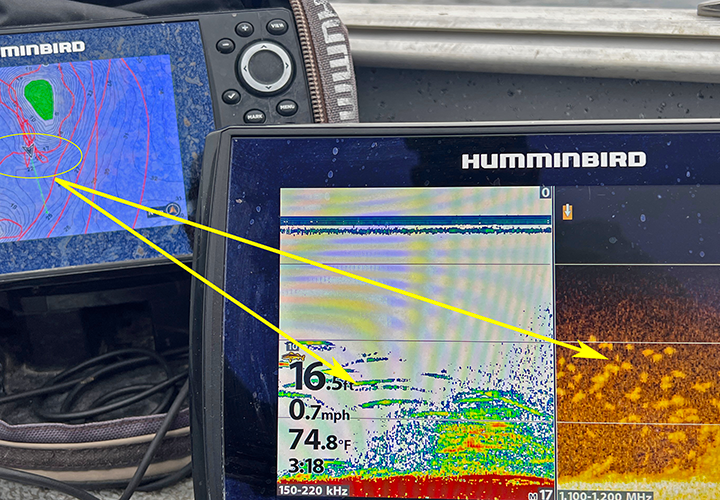 Strike King’s 2-inch Mr. Crappie tails were a close 2nd this time, but they have also been very effective lures for me over the past couple of seasons. The weight of the jigs, in both cases, depends on the water depth and type of cover we’re fishing over. Deeper fish, like you see pictured here, require the heavier, 1/8 ounce jigs. Shallow water, or for time when fish are embedded more deeply in the weeds, 1/16 ounc1/8-ounceovide more control, and less snagging in the grasses.
Strike King’s 2-inch Mr. Crappie tails were a close 2nd this time, but they have also been very effective lures for me over the past couple of seasons. The weight of the jigs, in both cases, depends on the water depth and type of cover we’re fishing over. Deeper fish, like you see pictured here, require the heavier, 1/8 ounce jigs. Shallow water, or for time when fish are embedded more deeply in the weeds, 1/16 ounc1/8-ounceovide more control, and less snagging in the grasses.
On that trip, casting toward the weeds and working the lures back using a slow drop-swim-drop-swim retrieve worked best. As you can see in the image of my graph screens, the fish were suspended. So, it worked best to avoid the bottom, we kept the lures swimming above to fish, in water depths of 6 to 9 feet.
Incidentally, that fishing trip, along with other trips I’ve done this week have prompted me to work on an update about fishing in and around the weeds. The article should be available sometime this weekend, Monday morning at the latest. So, watch for additional information, including more suggestions about tactics, lures and baits that are productive for both crappies and sunfish. ![]() — Office Call or Text 218-245-9858 or EMAIL or Facebook or X
— Office Call or Text 218-245-9858 or EMAIL or Facebook or X
 Ely Area, Arrowhead Outdoors Fishing Report August 6, 2025
Ely Area, Arrowhead Outdoors Fishing Report August 6, 2025
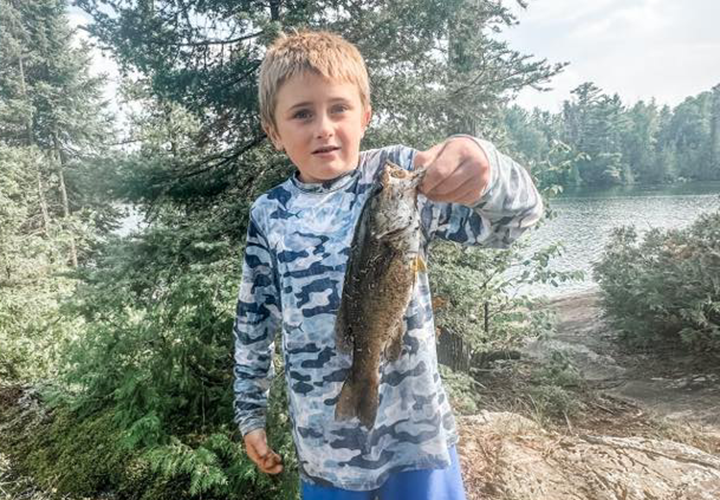 "Walleyes have really started to spend out this last week. Trolling during the day over large sand or mud flats in 15 to 25 feet of water has been very effective. Perch colors have been very effective here. For a shot at a trophy walleye, the suspended, deep water Cisco bite, during the last hour of light, is your best bet. Large white, blood nose, silver and blue, crankbaits that dive 15 to 20 feet down, fished over 30 to 60 feet of water, have been bringing in some giant walleyes.
"Walleyes have really started to spend out this last week. Trolling during the day over large sand or mud flats in 15 to 25 feet of water has been very effective. Perch colors have been very effective here. For a shot at a trophy walleye, the suspended, deep water Cisco bite, during the last hour of light, is your best bet. Large white, blood nose, silver and blue, crankbaits that dive 15 to 20 feet down, fished over 30 to 60 feet of water, have been bringing in some giant walleyes.
Some anglers have been reporting an excellent shallow water bite over shallow rocks in 4 to 7 feet of water. This bite often results in a handful of nice walleyes caught, then nothing, so keep moving to keep catching. Paddle tails have been very effective here. Still other anglers have been reporting an excellent minnow bite with 4 to 6 inch size minnows. Often, this bite is happening out on the sunken islands in 15 to 20 feet of water. With water temps well into the 70's anglers will need to keep their bait cold to keep it alive.
Smallmouth bass have now largely set up out on sunken islands. If you're looking for numbers of big smallies, you're going to find them out on sunken islands in that 15 to 25 feet of water, often suspended just off these humps. Swimming large swim baits for crankbaits has been very effective. If you can't find sunken islands or don't have any on your lake, shorelines are still holding good numbers of bass. Early morning topwater bite has been very effective. Once the sun gets up, switch to spinnerbaits, squarebills, wacky worms or chatterbaits to keep catching smallies. Downed trees, large boulder flats and sharp edges are all good places to find active bass.
Panfish - Crappies and sunfish continue to be found right in the thick coontail beds. Often time crappies and sunnies are being caught in as little as 2 feet of water, so don't be afraid to go really shallow. Jig and twister or crappie minnows under a bobber have been very effective. For sunnies, wax worms or angleworms, fished under a bobber has been very effective for them. Downed trees are also another great spot anglers should be looking for fish.
Stream Trout - Rainbow trout continue to be easy pickings for many anglers this last week. Anglers fishing from a boat seemed to have the best success. Trolling was the name of the game for these anglers. Trolling brightly colored, small floating raps, small trolling spoons or small spinners were all very effective this last week. Key is to get the bait down 10 to 15 feet and troll it over 30 to 80 feet of water.
Pike - Cooler temps this last week had reports of some bigger pike coming into the shop. Anglers fishing deep cabbage beds with cooler deep water close by, often reported catching or at least hooking a big pike. Large spoons, large spinnerbaits or large minnow baits often produced the best results for anglers. If you're just looking for pike for a meal, throw spoons in and around weedbeds, river mouths and mouths of shallow bays. Shouldn't take long." — Arrowhead Outdoors, 218-365-5358
 Lake of the Woods, LOW Tourism August 6, 2025 "NEW! Real-Time Wave Height Data Now Available"
Lake of the Woods, LOW Tourism August 6, 2025 "NEW! Real-Time Wave Height Data Now Available"
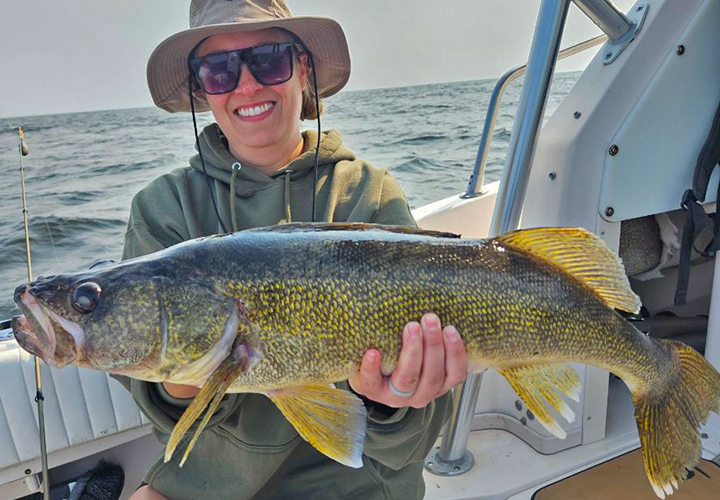 "Lake of the Woods Tourism has deployed wave buoys on Lake of the Woods! Boaters, anglers, and guides can now check real-time wave height data from three key locations: Big Traverse Bay West, Big Traverse Bay East and the Northwest Angle. Whether you're planning your next trip across the lake, a charter outing, or just curious what the lake is doing, this is a great new tool. To access the data and buoy locations, follow this link to use the Lake of the Woods Wave Height Tool.
"Lake of the Woods Tourism has deployed wave buoys on Lake of the Woods! Boaters, anglers, and guides can now check real-time wave height data from three key locations: Big Traverse Bay West, Big Traverse Bay East and the Northwest Angle. Whether you're planning your next trip across the lake, a charter outing, or just curious what the lake is doing, this is a great new tool. To access the data and buoy locations, follow this link to use the Lake of the Woods Wave Height Tool.
On Lake of the Woods' Big Traverse Bay, the Deep Mud Bite is Hot! Summer fishing continues to shine on Lake of the Woods, and Big Traverse Bay is delivering excellent walleye action! The current trend? Targeting walleyes over the deep mud basin in 30 to 35 feet of water. Anglers are watching their electronics closely and finding big schools of fish scattered across the basin.
The go-to technique this week has been drifting or trolling crawler harnesses at speeds of 1.0 to 1.25 mph. Hammered gold blades paired with red, pink, orange or chartreuse continue to be solid producers. Not only are anglers catching good numbers of fish, but plenty of protected slot size walleyes (19.5 to 28 inches) and trophies are also in the mix.
Trolling crankbaits is also catching fire. Anglers are using leadcore line, snap weights, or downriggers to get their cranks down into the strike zone. This technique is not only helping to cover water but is producing some of the biggest walleyes of the season so far. In the stained waters of LOW, firetiger, pink UV, chrome/blue, and gold are go-to colors.
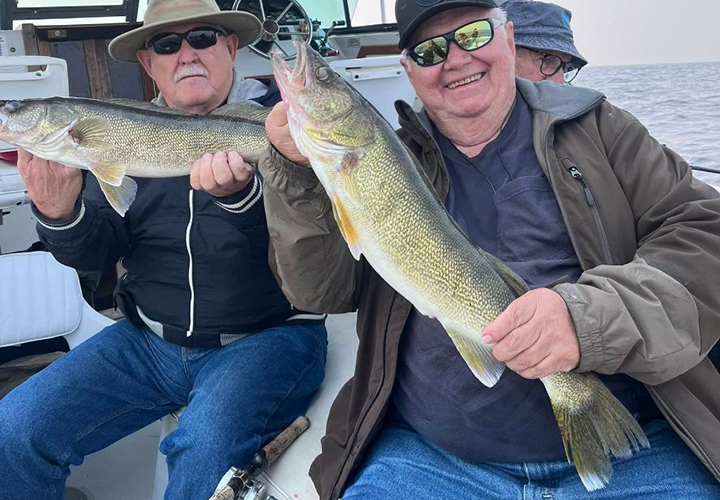 Those who enjoy forward-facing sonar are finding good numbers of big walleyes over the deep mud basin. The basin is loaded with walleyes, and for those wanting to work on their electronics game and land some giants, now is the time.
Those who enjoy forward-facing sonar are finding good numbers of big walleyes over the deep mud basin. The basin is loaded with walleyes, and for those wanting to work on their electronics game and land some giants, now is the time.
On the Rainy River, the mixed bag fishing and Sturgeon season is in play. Summer on the Rainy River offers something for everyone. Anglers are catching a nice variety of walleyes, smallmouth bass, and pike, especially near current breaks, deeper holes, and shoreline structure.
Sturgeon fishing is also in full swing. The keep season is open through September 30. Anglers with a valid sturgeon tag can harvest one sturgeon per calendar year that measures 45 to 50 inches or over 75 inches. Soaking a combination of nightcrawlers and frozen shiners on a sturgeon rig continues to be the best presentation.
Northwest Angle, consistent Action. Up at the Northwest Angle, both the Minnesota and Ontario sides are producing excellent fishing. Anglers are targeting walleyes with a mix of techniques: Pulling spinners with crawlers, trolling crankbaits around reefs and points and jigging with minnows or plastics in neckdown areas, around structure, and on the edges of mud and rock transitions.
Bonus species like smallmouth bass, pike, perch, and crappies are showing up as well, providing exciting multi-species action. Muskie anglers are tight lipped, but reports have been consistent with anglers seeing and boating good fish. Some fish are exceeding that 50 inch mark.
Now’s the Time to Visit! Whether you're chasing your personal best walleye or looking to enjoy a classic shore lunch with family and friends, Lake of the Woods is firing on all cylinders. From the basin to the river to the NW Angle, the fishing is excellent, the scenery is stunning, and the memories are waiting to be made." — Lake of the Woods Tourism, (800) 382-FISH
 August 4, 2025 "Best Fishing Presentaions For Kids?"
August 4, 2025 "Best Fishing Presentaions For Kids?"
on August 4, 2025, Sofia Martinez wrote,
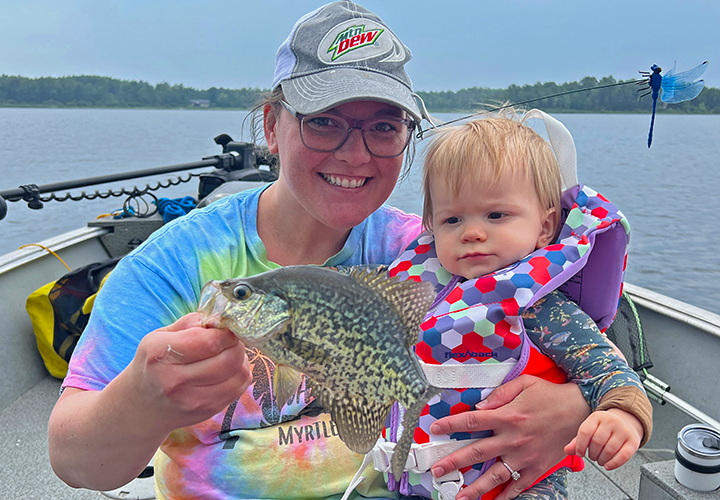 Q) “Mr. Jeff, I’m confused. On Friday (08-01-2025) you wrote that the best way to catch fish for 8-year-old girl, Lucy was to fish slow with a jig and night crawler. Then on Sunday (08-03-2025), I read that the best way for the 10-year-old boy, Emmett, was to troll fast with spinners and live bait. We want to help our kids catch more fish and want to know more about the best ways to do that. Will you please explain, why is there a difference between fishing with the 2 kids in your reports?
Q) “Mr. Jeff, I’m confused. On Friday (08-01-2025) you wrote that the best way to catch fish for 8-year-old girl, Lucy was to fish slow with a jig and night crawler. Then on Sunday (08-03-2025), I read that the best way for the 10-year-old boy, Emmett, was to troll fast with spinners and live bait. We want to help our kids catch more fish and want to know more about the best ways to do that. Will you please explain, why is there a difference between fishing with the 2 kids in your reports?
A) Sofia, thank you for the note and for the great questions. You’re right, the “best” presentations we used for catching fish on these 2 days were completely different from each other. The variations though were not because of differences between the 2 kids; they were due to the differing structures and scale of the terrain where we were fishing. Also, the fish species we were trying to catch were different as well, so lets start there.
Last Thursday, the lake where Lucy and her dad were fishing only had a few fish species in it. Smallmouth and largemouth bass, along with a handful of sunfish are the only fish we could target. On Saturday, fishing with Emmett and his dad, the lakes offered a much wider range of fish species to target, northern pike, walleye, bass, sunfish, crappies, rock bass, perch and others all share the same weed edges.
The second difference between the 2 situations is the size and scale of the structures in the lakes. Lucy’s lake was small, under 400 acres and the spots in it were also small and isolated, some of them were only 20 to 30 yards long. Fishing those small spots using slow, finesse style presentations was both easy, and efficient.
Emmett’s lake, on Saturday, was large, thousands of acres spreading out in every direction. The fishing spots on that lake are large too, sometimes spanning areas up to a quarter mile. Trying to cover all of that territory using slow presentations, it could take hours just to fish one weed line. So, trolling spinners is not only a more effective way to cover water, but the faster moving presentations appeal to a wider variety of fish species as well.
Another factor to consider is the weather, and I have a new example for you that occurred just yesterday.
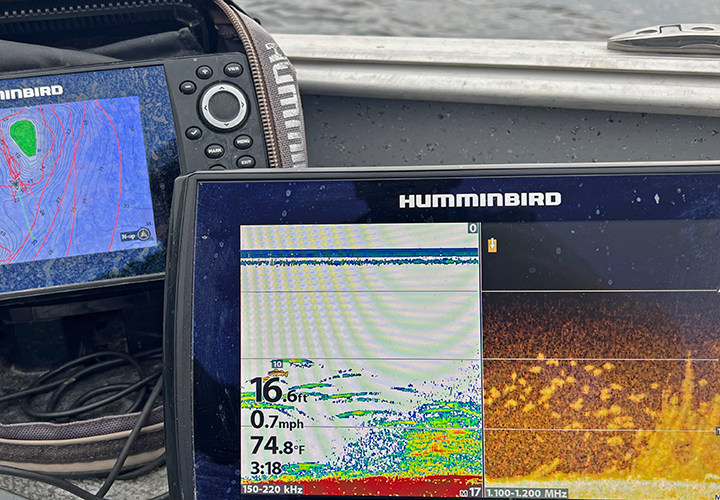 In both reports you mentioned, the weather conditions were the same. It was sunny, and the breeze was light. Because of the bright conditions, the fish were reluctant to roam freely outside of the weeds. When we first encountered them, they struck our lures, but once they were alerted to our presence, they were much harder to catch. For me, constantly covering fresh territory was the only way to pick off fish before they became “boat shy”. On a cloudy day, fish are less wary, so we have more options of presentations that will catch them.
In both reports you mentioned, the weather conditions were the same. It was sunny, and the breeze was light. Because of the bright conditions, the fish were reluctant to roam freely outside of the weeds. When we first encountered them, they struck our lures, but once they were alerted to our presence, they were much harder to catch. For me, constantly covering fresh territory was the only way to pick off fish before they became “boat shy”. On a cloudy day, fish are less wary, so we have more options of presentations that will catch them.
For example, on Saturday, Emmet and his dad would have been thrilled to catch some crappies, but in the sunshine, we could not get them to come out of the weeds. On Sunday, it was cloudy and breezy and fishing the same lake, in the same spot, crappies were more than willing to strike. Look at the image of the school of crappies on the screen of my graph . You can see the weeds, to the right, and that under dark skies those crappies moved out of the weeds and were located in open water. In this situation, we first used spinners to locate the fish and then stopped the boat and fished for them from a stationary position.
At first we used small jigs tipped with live minnows, Dropping the jig over the side of the boat and letting it fall about halfway to the bottom worked for a while. Then those fish became wary, and casting the same jigs tipped with small plastic tails further away from the boat worked better. There were several artificial lures that worked, but Berkely’s 1 inch … was the most productive. If your kids have trouble casting and retrieving lures, then using slip bobbers set to about 9 feet would have worked well in the situation too.
I hope that you'll think of it this way, there is no one presentation that will always be the “best one” for your kids. But if you learn to understand how some of the basic weather conditions affect fish. You'll learn fast when to use spinners and when to use slower presentations like the jigs with either live bait, or plastic tails. Master these 2 fundamental presentations and you will have 90% of the multi-species fishing situations covered. Then as your kids gain experience, experimenting with other more species-specific presentations will get to be fun, and before long, your kids will be teaching you the tricks about catching fish and doing it “their way”.
For me, answering reader questions, like this one from Sophia, is a great way to help teach folks better ways to catch fish. So, don't be shy, this is your invitation! When you have a question, or comment about one of the FishRapper daily reports get in touch and let folks know what’s on your mind! ![]() — Office Call or Text 218-245-9858 or EMAIL or Facebook or X
— Office Call or Text 218-245-9858 or EMAIL or Facebook or X
 August 3, 2025 "A Typically Typical Summer Fishing Report"
August 3, 2025 "A Typically Typical Summer Fishing Report"
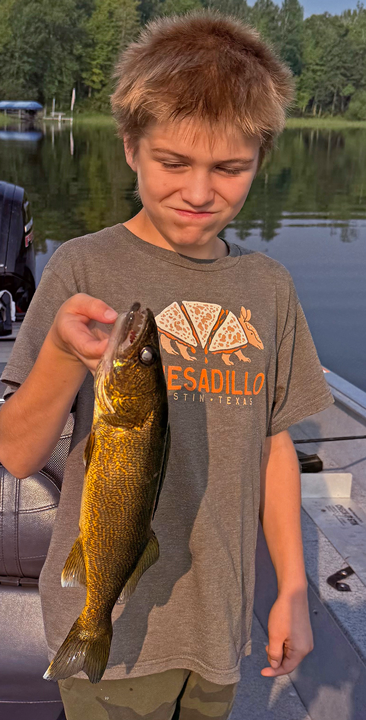 If you were 10 years old, and just wanted to catch some fish, you probably wouldn’t care which presentation you used to catch them. It’s likely too that the fish species you catch is not the most important factor in deciding where to pursue them. That’s because for a kid, there are only 2 main species of fish, big ones, and little ones. Now their parents may, and often do, influence which fish species we target, but all things equal, “action”, combined with a chance at “something big” is what really motivates kids. These are the top reasons why the “mixed bag action bite” dominates my fishing reports during mid-summer.
If you were 10 years old, and just wanted to catch some fish, you probably wouldn’t care which presentation you used to catch them. It’s likely too that the fish species you catch is not the most important factor in deciding where to pursue them. That’s because for a kid, there are only 2 main species of fish, big ones, and little ones. Now their parents may, and often do, influence which fish species we target, but all things equal, “action”, combined with a chance at “something big” is what really motivates kids. These are the top reasons why the “mixed bag action bite” dominates my fishing reports during mid-summer.
The basic formula for going into the fishing trip with Uriah and Emmet Peterson on Saturday was exactly that. We hoped to keep 10-year-old Emmet busy, but at the same time, hoped to catch a few walleyes, and maybe a nice pike and some crappies.
The summertime presentation you here so much about, trolling spinners over the weed tops, was chosen not because it’s the best way to catch any one of those species. Rather, it’s the best way to serve all of the goals at the same time. Knowing that “the adults” may single out and catch more fish of a given species by using more specialized presentations, serving the needs of the kids ranks higher in deciding the methods.
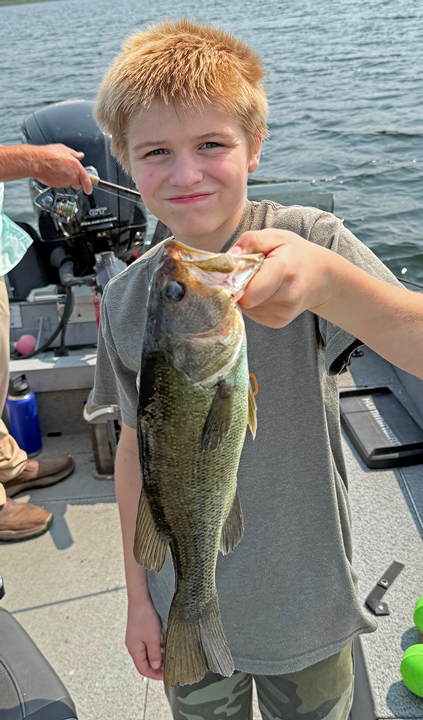 The reason that I’m bringing it up today is because for a short time on Saturday, I fell into a trap of my own making. My brain was focused on the desire to get more of the higher quality target fish like walleyes and crappies. So, the fishing spots I chose were ones that I hoped would help us accomplish those goals. Usually, we would catch enough of everything else, that would hold the attention of a youngster. Yesterday though, clearer water, combined with sunshine and calm water counteracted the action part of the action bite. So, by about 11:30, it was clear that Emmet wasn’t going to last the whole day unless I did something different.
The reason that I’m bringing it up today is because for a short time on Saturday, I fell into a trap of my own making. My brain was focused on the desire to get more of the higher quality target fish like walleyes and crappies. So, the fishing spots I chose were ones that I hoped would help us accomplish those goals. Usually, we would catch enough of everything else, that would hold the attention of a youngster. Yesterday though, clearer water, combined with sunshine and calm water counteracted the action part of the action bite. So, by about 11:30, it was clear that Emmet wasn’t going to last the whole day unless I did something different.
“Let’s do this, we’ll run back to the landing, let Emmet stretch his legs a little, and then switch to a different lake,” I advised dad. That sounded like a good idea, so we made a move.
We knew going into the 2nd lake that walleyes would now be off the table. But crappies, bass, northern pike and sunfish should keep us busy. The way it turned out, some of those alternatives did strike our spinners, but sunfish were on fire. For a time, we couldn’t go more than a few yards without getting a strike. Every so often, a nice bass, or an occasional northern pike struck too, and they satisfied the need to get an occasional big fish. I would have been happier if Plan A had worked out better. But all things considered, Plan B was a bigger hit for Emmet and truthfully, I felt that it saved our day.
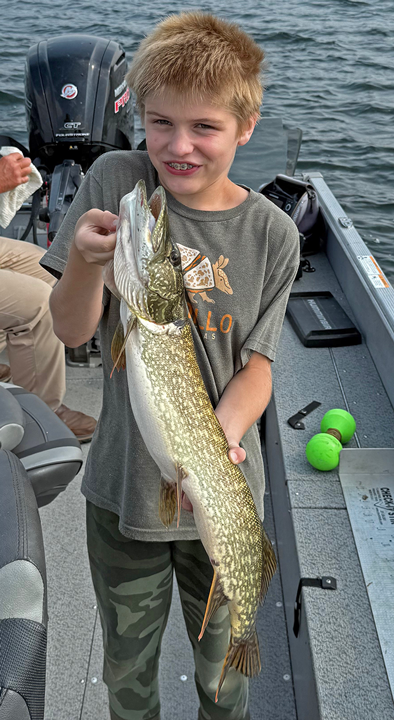 Details about the fishing trip are very typical of recent reports. Surface water temperatures ranged between 74 and 76 degrees. The deeper, cooler, Pokegama Lake vs the slightly stained, shallower alternative Plan B Lake.
Details about the fishing trip are very typical of recent reports. Surface water temperatures ranged between 74 and 76 degrees. The deeper, cooler, Pokegama Lake vs the slightly stained, shallower alternative Plan B Lake.
Single 2/0 Aberdeen hook, #4 hammered gold spinner blades behind a 3/16-ounce bullet sinker were the lures. We tipped them with night crawlers for the sunfish and used minnows to trigger more pike and bass. Trolling speeds in the warm water were faster than usual for me, 1.3 to 1.5 MPH kept the lures running cleanly above the heavy weed tops.
The harvest consisted of a couple of walleyes that Emmet caught at the first lake. A bunch of sunfish, a few smaller bass and a couple of pike. We would have harvested more northern pike, but many of our better specimens fell into the range of protect slot sizes. We released several 23-to-25-inch fish.
Okay that is the “typically typical” fishing report for today. If there is a key takeaway, I guess it is this. When the goal is to hold the attention of a youngster on a fishing trip, “reading the room” is important. I have fished with kids, adults too, that can go for long periods between strikes. There are others though that aren’t wired that way, for them, something has to happen fairly often. I could have turned the trip into a disaster by ignoring the fact that I was losing my audience. Luckily, the move to Plan B worked out, and the trip turned into a successful one.
 August 3, 2025 "Big Sandy Lake Walleye Slot Limits"
August 3, 2025 "Big Sandy Lake Walleye Slot Limits"
As it happens, today’s report ties into a comment that came from my report about fishing on Big Sandy Lake. From the FishRapper, Fishing Reports Minnesota Facebook Page.
Q) Brian Castellano wrote, “We love camping at Big Sandy, but get frustrated by the (14-to-18-inch keeper range) walleye slot. Any thoughts on why there's so many just under 14" fish Jeff Sundin?
A) Brian, the quick answer to your question may sound simplistic, but nonetheless it is true. Anglers, as a group, have become very efficient at catching fish. Species like walleyes, that are sought after primarily for food, are harvested quickly and efficiently. On Big Sandy, small fish are released, but most fish that reach the legal, 14-to-18-inch harvest size are kept. Because the pressure on those “keepers” is so high, relatively few of them remain in the lake to become trophies.
Slot limits of any type, on any lake reveal the effectiveness of angling on fish populations. Everywhere in the country, lakes with minimum size limits on popular harvest species have high populations of fish that measure short of the legal harvest size. On lakes that have protected slot sizes, like Lake Winnibigoshish for example, many fish in the legal-size range are harvested within a few years of their birth. Then, remaining fish from that year class begin stacking up in the protected slot size range.
The real question is why fisheries managers choose to use one type of slot regulation over another one. That’s why your question prompted me to contact the Aitkin area fisheries office to discuss how, and why the 14-to-18-inch harvest slot was chosen for lakes like Big Sandy, Farm Island and others. Watch for more updates, and as time allows, I’ll follow up on those discussions, which hopefully will shed more light on the specifics about those management decisions.
In the meantime, let me throw in my opinion. I realize that it’s not for everybody, but I actually like the harvest slot on Big Sandy Lake. One caveat, I never fish the lake with folks whose intent it is to catch full bag limits of fish. Rather, I go there with families who want to harvest some fish but primarily seek action over quality size. For kids especially, I can usually count on catching enough walleyes to keep them busy. For the adults, I can usually get enough walleyes to provide 1, or maybe 2, family fish dinners. As always, I just try to match the right people with the right lake. ![]() — Jeff Sundin, The Early Bird Fishing Guide Office Cell Call or Text 218-245-9858 or Email on Facebook on X
— Jeff Sundin, The Early Bird Fishing Guide Office Cell Call or Text 218-245-9858 or Email on Facebook on X
 August 1, 2025 "Lucy, You've Got Some Splainin' To Do!"
August 1, 2025 "Lucy, You've Got Some Splainin' To Do!"
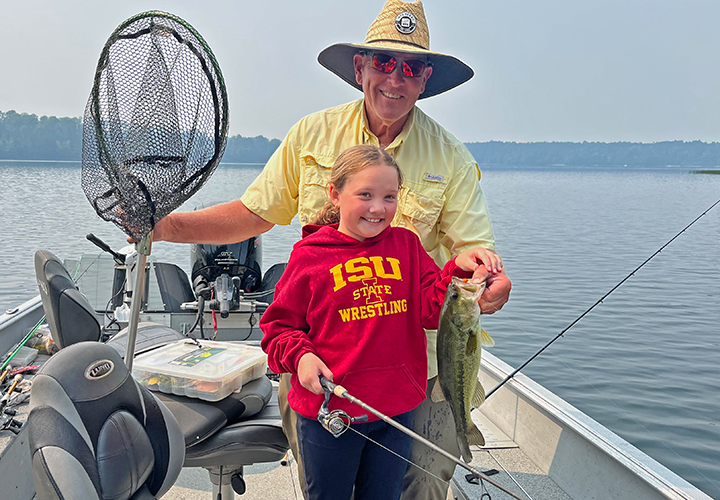 You’ve fished with kids before, haven’t you? If you haven’t, then you’ve missed out on some “cute and quirky” behavior. It can be hard to recognize when it will happen, but sometimes, the cute little quirks wind up having a profound impact on a fishing trip, maybe even on a lifetime of fishing trips.
You’ve fished with kids before, haven’t you? If you haven’t, then you’ve missed out on some “cute and quirky” behavior. It can be hard to recognize when it will happen, but sometimes, the cute little quirks wind up having a profound impact on a fishing trip, maybe even on a lifetime of fishing trips.
Yesterday, here’s what the adults were saying to 8-year-old Lucy Patterson. “First you need to cast the Ned Rig toward the weedline, then let it drop on a tight line, and then when you feel a tick on the line, you have to set the hook, pop it hard. Then once you set the hook, make sure to keep the line tight, then keep your rod tip high, and don’t let the bass swim back into the weeds. Remember, keep your rod away from the boat, no wait, sometimes you have to bring the rod closer to the boat, then reel harder, no wait, reel softer, then reel faster, no, hold on, reel slower and then ...” you get the idea.
Eight-year-old Lucy had a simple question though. “Why can’t I just put on a worm my hook and drop it over the side, and fish under the boat?”
At first, I started down a complicated path, trying to explain about how the little sunnies and perch would pick the worm apart until her hook was empty, but then, I stopped myself. “You know what Lucy? I said, if it makes you happy to fish under the boat, where you can watch the little fish nip at your hook, then go ahead,” if it's fun for you, it's fun for me.
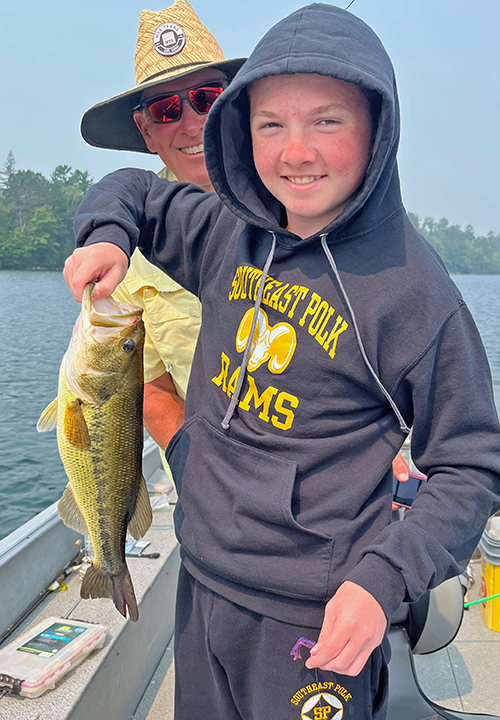 Baited up and ready to go, she drops her jig over the edge of the boat and into the water. “Ooh, there’s a nice bass down there,” Lucy said. “Ooh look, it’s swimming toward my bait and "HEY I GOT HIM!” she exclaimed. That scenario played out more than a few times during Lucy's short afternoon trip. Technically, this was supposed to be the end of today's fishing report because it happened at the end of the day, after the adults had done the “hard core” portion of the fishing day.
Baited up and ready to go, she drops her jig over the edge of the boat and into the water. “Ooh, there’s a nice bass down there,” Lucy said. “Ooh look, it’s swimming toward my bait and "HEY I GOT HIM!” she exclaimed. That scenario played out more than a few times during Lucy's short afternoon trip. Technically, this was supposed to be the end of today's fishing report because it happened at the end of the day, after the adults had done the “hard core” portion of the fishing day.
Fast rewind to that hard-core, big-time portion of the trip. It began earlier, when Patrick, Landry and I attempted to catch Lake Trout. Long story short, the duration of our laker expedition only lasted about 2 hours. While we were at it, we trolled crankbaits, vertically jigged with tubes and plastic swimbaits, then cast and retrieved big heavy rattle baits and dabbled with other ideas. None of the presentations we tried were successful. Even though there were occasionally fish on the screen of my graph, none of them struck.
Understand, it takes a certain type of passion to keep fishing when nothing seems to be happening. Unless an angler is prepared to spend all day working on a project like this, the urge to find some fish that are biting inevitably takes over. So, by about 10:00 am, bass fishing sounded like a great idea.
The lake, clear and rocky, has all kinds of tantalizing structures like rocky points, sunken logs and even whole trees submerged below the surface. We fished many of them, and there were both smallmouth and largemouth bass on some of them. But the action got more serious when we discovered “the formula”. Small patches of heavier weed growth, lying adjacent to deeper water, but on slower tapering shoreline breaks held the most fish. Key water depths varied, but 14 to 16 feet of water was ideal.
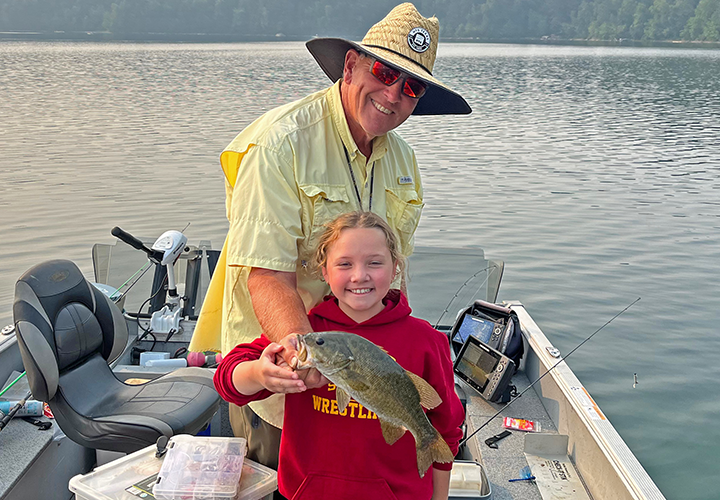 Typical of most of these clear water trout lakes in the Grand Rapids region, bass tends to be numerous, but not usually the biggest size. That was true of our catch yesterday, lots of fish in the 10-to-12-inch range were boated. There was a fair number of 12-to-14-inch fish, and a smattering of larger, 16-to-19-inch fish in the mix too. Whatever the lake’s fish lacked in size, was more than made up for in terms of the action they provided; perfect for the kids!
Typical of most of these clear water trout lakes in the Grand Rapids region, bass tends to be numerous, but not usually the biggest size. That was true of our catch yesterday, lots of fish in the 10-to-12-inch range were boated. There was a fair number of 12-to-14-inch fish, and a smattering of larger, 16-to-19-inch fish in the mix too. Whatever the lake’s fish lacked in size, was more than made up for in terms of the action they provided; perfect for the kids!
The Ned Rigs mentioned earlier worked great for Patrick; he caught numerous fish using a drop-hop-drop-hop retrieve. The color of the one you see pictured here was his early favorite. But when the supply of that color was exhausted, others were tried and all of them worked equally well. For Landry, a Z Man TRD Tube paired with a Ned Rig jig head worked well too. The color, … was the only one we tried, so it’s hard to say if it was better than any other or not.
While the boys fished with those lures, I experimented with alternatives. Wacky worms, swim baits, twirl tails and Texas rigged worms were all tried. Most of them attracted a few fish, but no presentation compared to the rigs my crew was using, except one. The 1/8-ounce live bait jig tipped with ½ night crawler that Lucy used turned out to be a fabulous alternative to the artificial lures.
 Before you turn up your nose at using live bait for bass fishing, remember who was using it. Lucy, at 8 years old may not have been ready for the artificial lures that the boys used. But once she had the jig and crawler combo in here hands, she crushed the bass. Numerous largemouth, and a few smallmouth bass came to the net, and for me, that was all that mattered. As Patrick made his last few casts of the annual fishing trip, Lucy topped off the day with one of each, pictured above, and provided us with a smiley grand finale’.
Before you turn up your nose at using live bait for bass fishing, remember who was using it. Lucy, at 8 years old may not have been ready for the artificial lures that the boys used. But once she had the jig and crawler combo in here hands, she crushed the bass. Numerous largemouth, and a few smallmouth bass came to the net, and for me, that was all that mattered. As Patrick made his last few casts of the annual fishing trip, Lucy topped off the day with one of each, pictured above, and provided us with a smiley grand finale’.
There you have it; the Patterson family fishing trip is a wrap for this year. The crew is heading home with a decent amount of fish but no limits. I think it’s fair to say that if success was measured by the weight of our larder, we could have done better. But not unlike the first time the Patterson’s fished with me some 35 years ago, (when Patrick was “the kid”), everybody experienced something more important than poundage. I think the right word is joy, the joy of discovery, of accomplishment, of memories that last and will never fade.
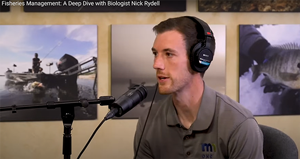 Before I go, let me mention Nick Rydell, MN DNR Fisheries research scientist. Rydell has been studying, among other things, the impact that forward facing sonar may, or may not, be having on fish populations in Minnesota. At the MN DNR Fisheries Summit, Rydell presented results from surveys conducted in 2023 and 2024. In a nutshell, early findings suggest that forward facing sonar does not impact fish harvest rates.
Before I go, let me mention Nick Rydell, MN DNR Fisheries research scientist. Rydell has been studying, among other things, the impact that forward facing sonar may, or may not, be having on fish populations in Minnesota. At the MN DNR Fisheries Summit, Rydell presented results from surveys conducted in 2023 and 2024. In a nutshell, early findings suggest that forward facing sonar does not impact fish harvest rates.
I interviewed Rydell myself this spring and will present my own formal report about those studies. In the meantime, Rydell’s findings, while preliminary, are making their way into the media.
Gerry Albert, retired MN DNR Large Lake Specialist for Lake Winnibigoshish aent me a special request that I provide a link to an interview with Rydell on the Angling Buzz YouTube channel. The interview, a lengthy 1 hour plus production covers a variety of topics, all of which are, or should be of concern to every angler who fishes on Minnesota waters. The discussion about forward facing sonar appears during the interview with Jeremy Smith. Follow the link to view full video >> Fisheries Management: A Deep Dive with Biologist Nick Rydell
Today, I have scheduled maintanance, paperwork and maybe, if I'm lucky a quick trip to try out another new lake. Saturday morning are typically my "day off" from writing reports, but your questions and comments are always welcome. Tomorrow, watch for a reader Q&A about Big Sandy Lake Walleyes. ![]() — Jeff Sundin, The Early Bird Fishing Guide Office Cell Call or Text 218-245-9858 or Email on Facebook on X
— Jeff Sundin, The Early Bird Fishing Guide Office Cell Call or Text 218-245-9858 or Email on Facebook on X
 Wired2Fish "Ned Rigs: The Complete Guide to Ned Rig Fishing"
Wired2Fish "Ned Rigs: The Complete Guide to Ned Rig Fishing"
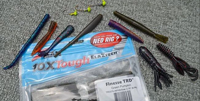 "Ned rig fishing has become one of the most popular finesse techniques and fishing rigs for catching bass all over the world. It’s a simple, do-nothing looking rig that has proven to have a wide appeal to largemouth, smallmouth and spotted bass all across the country and beyond.
"Ned rig fishing has become one of the most popular finesse techniques and fishing rigs for catching bass all over the world. It’s a simple, do-nothing looking rig that has proven to have a wide appeal to largemouth, smallmouth and spotted bass all across the country and beyond.
WHAT IS A NED RIG? Born out of the midwest finesse niche in bass fishing by none other than Ned Kehde, the ned rig is simply a small plastic, usually 2 to 3 inches long without much else to it rigged on a mushroom head jig. The original was basically half of a Yamamoto Senko threaded onto a mushroom head.
The Ned rig ..." Read Full Story to Learn More >> Ned Rigs: The Complete Guide to Ned Rig Fishing